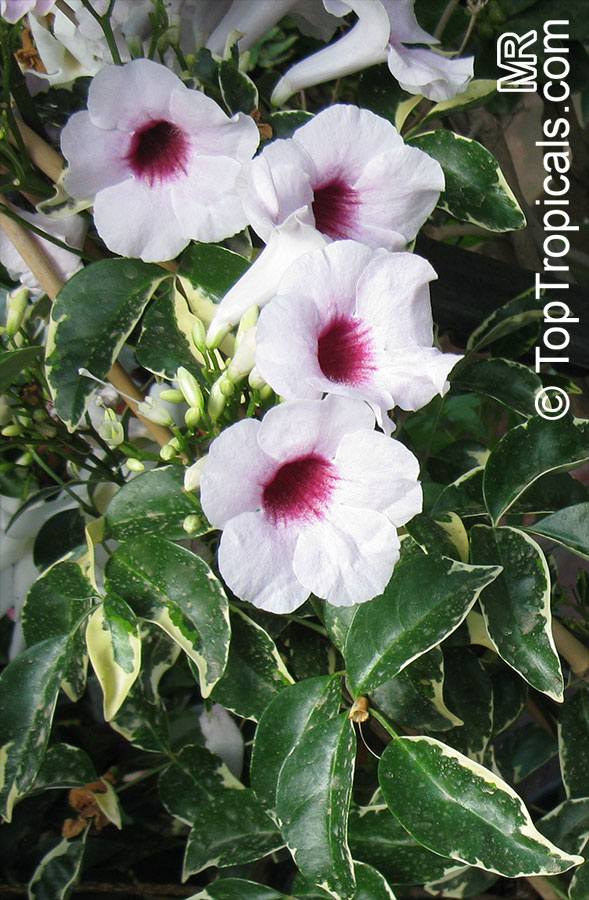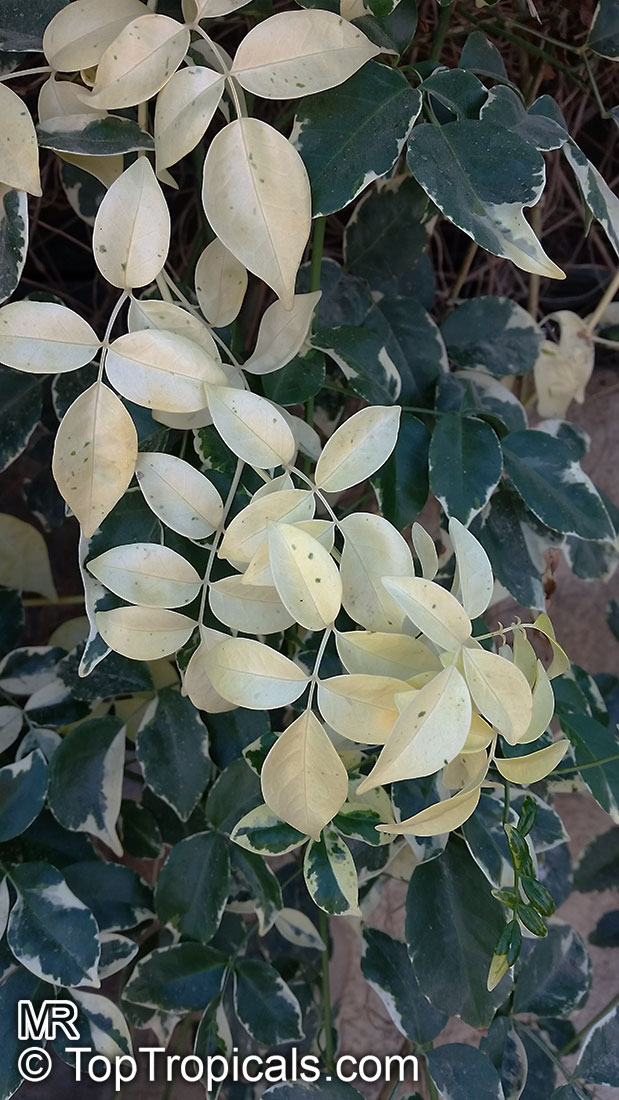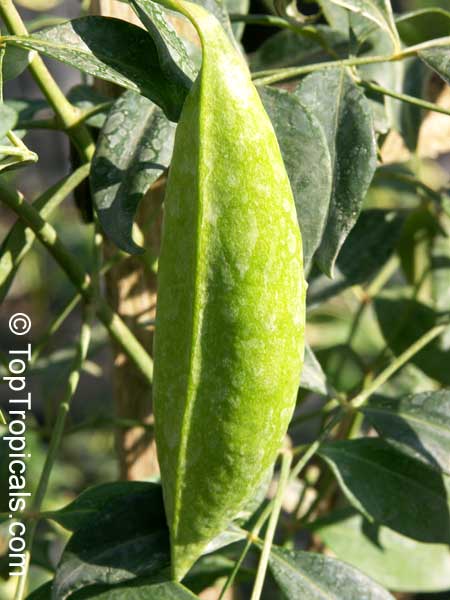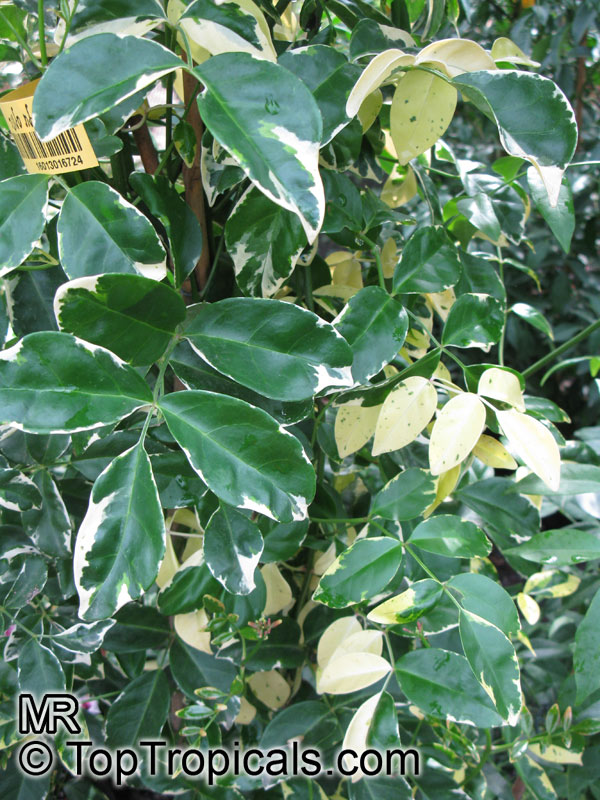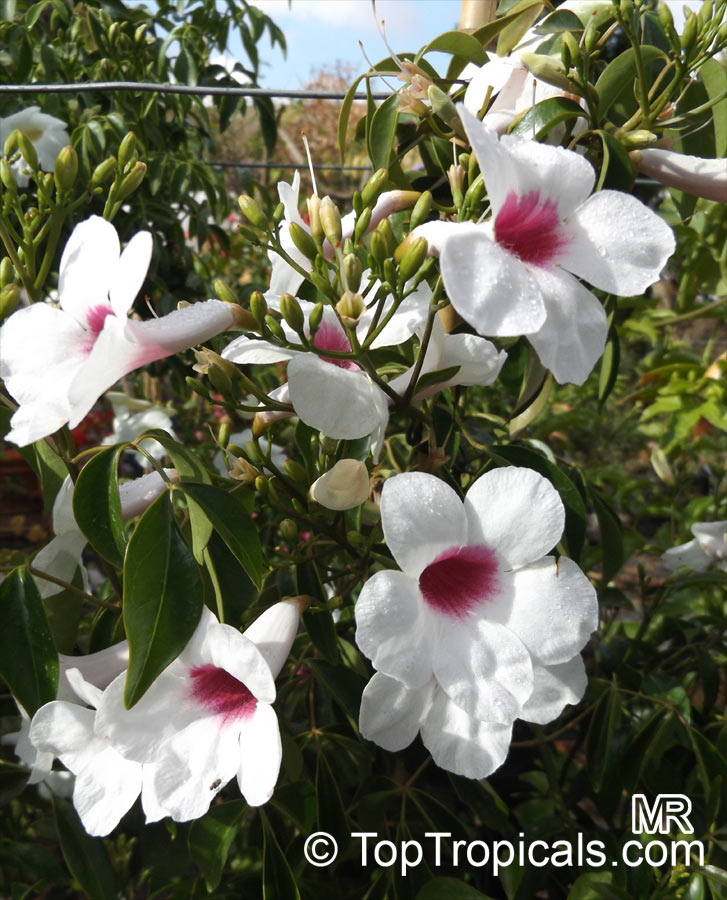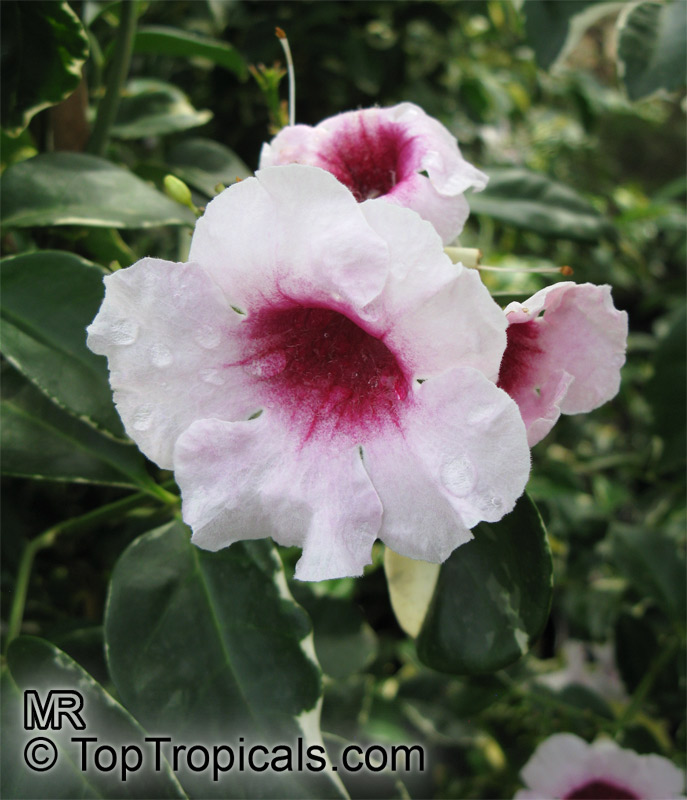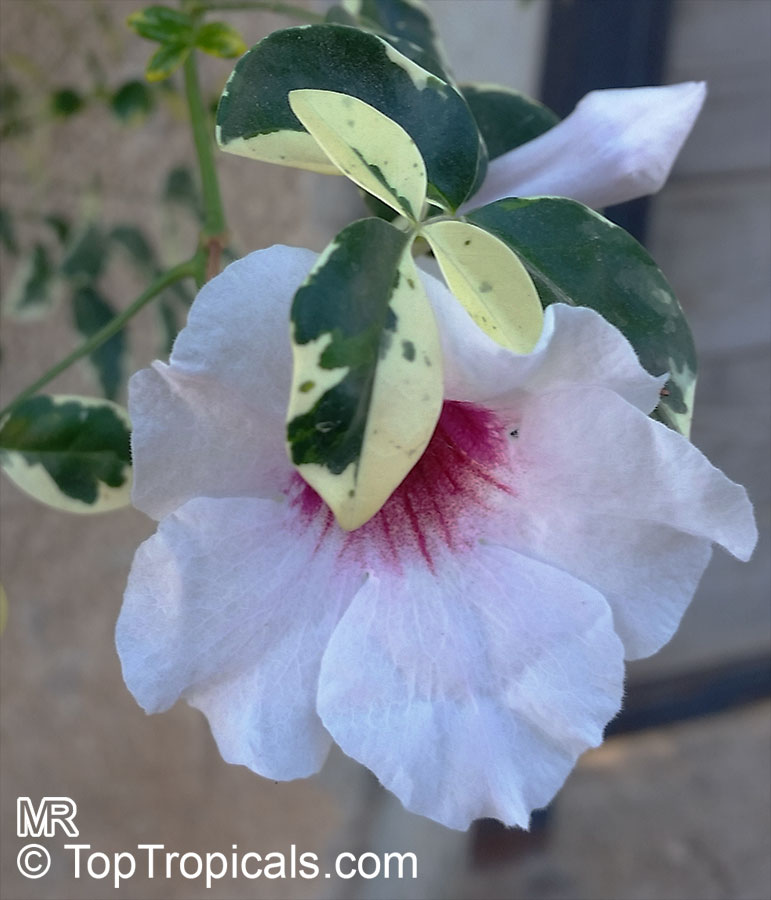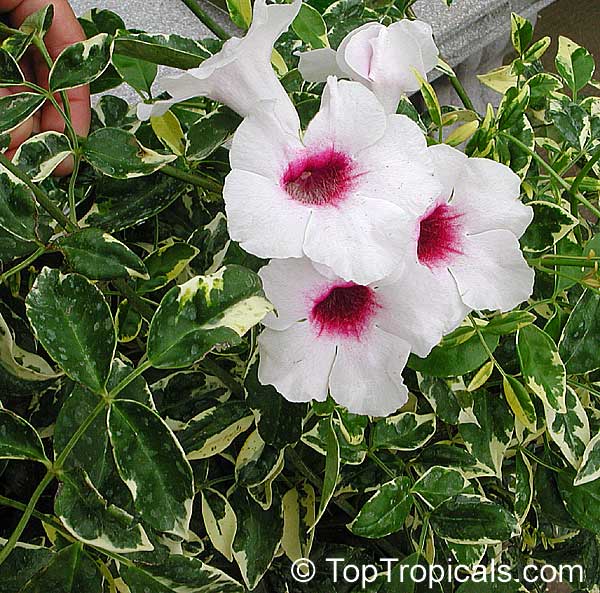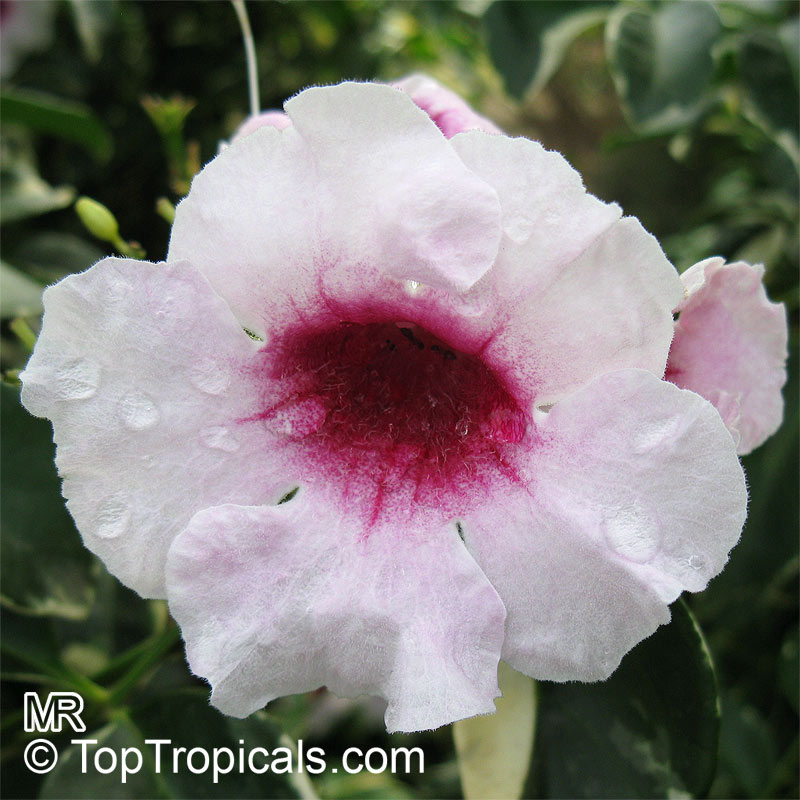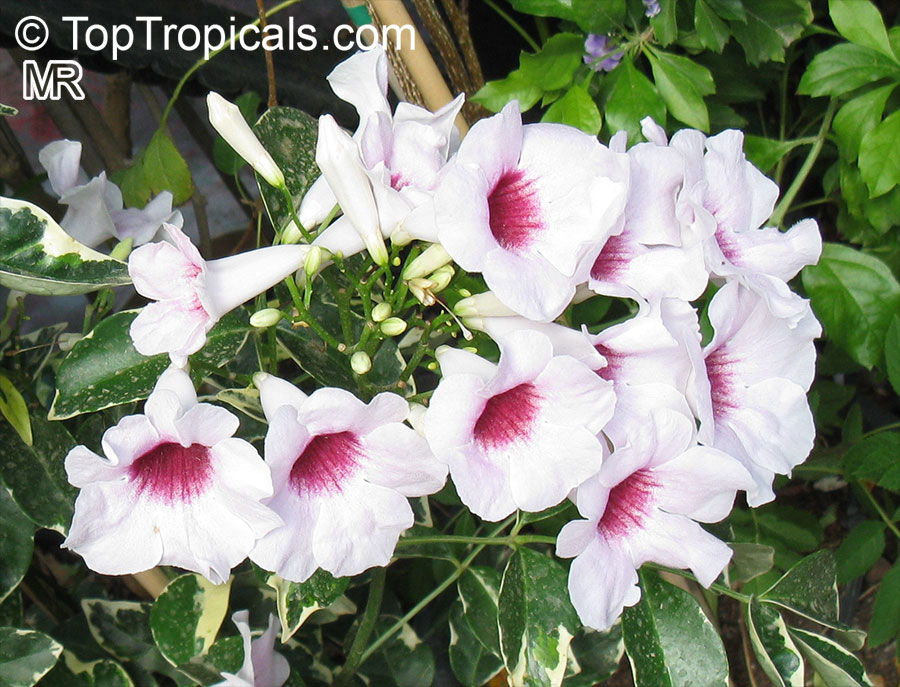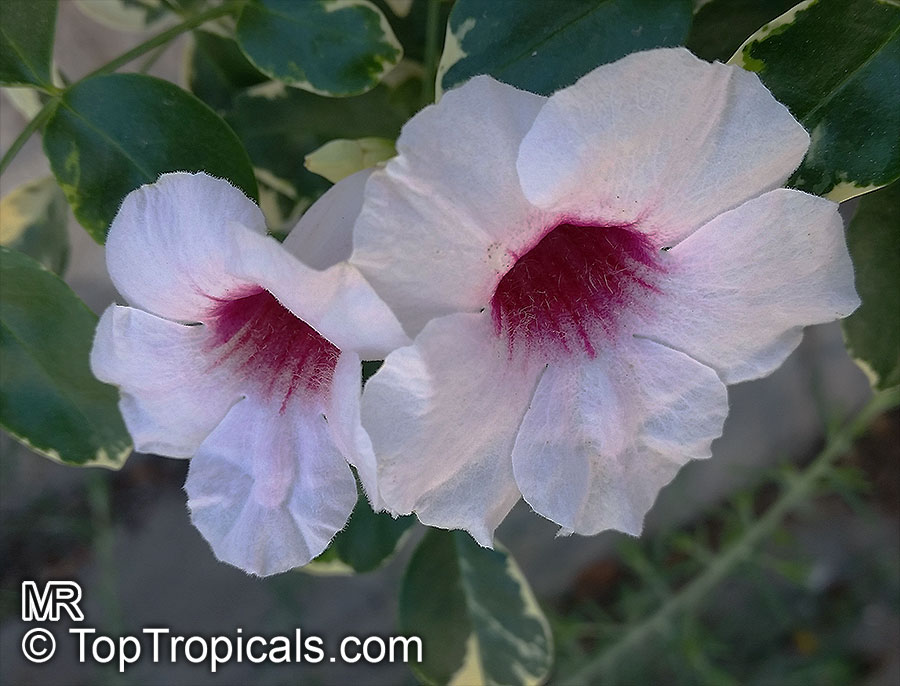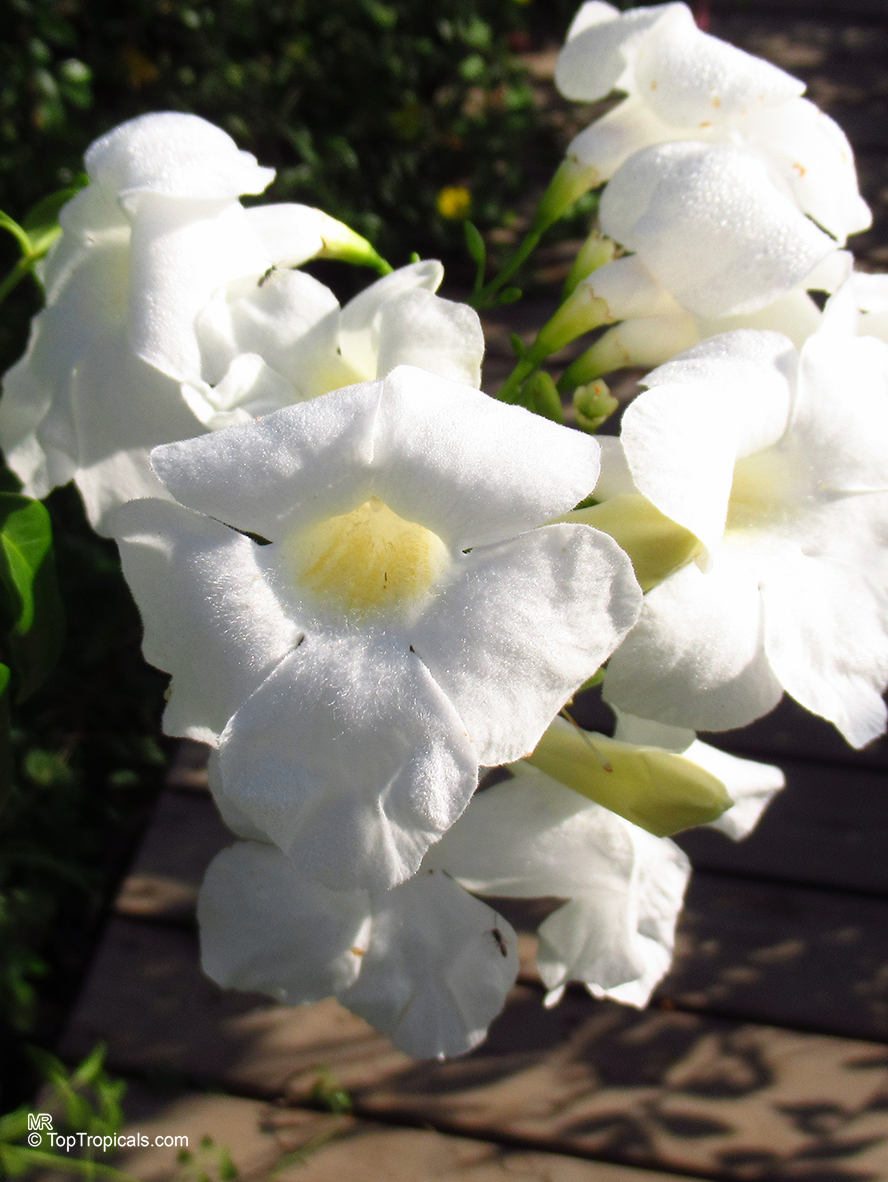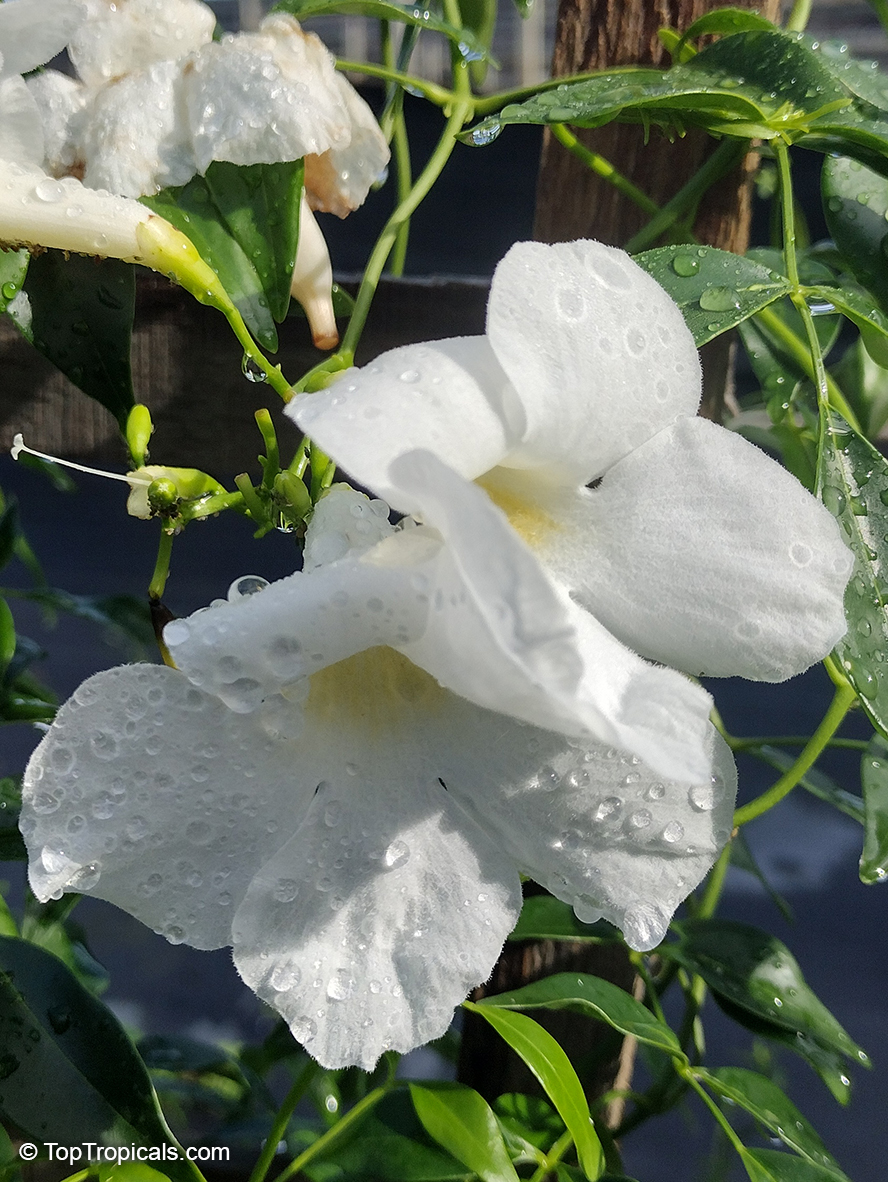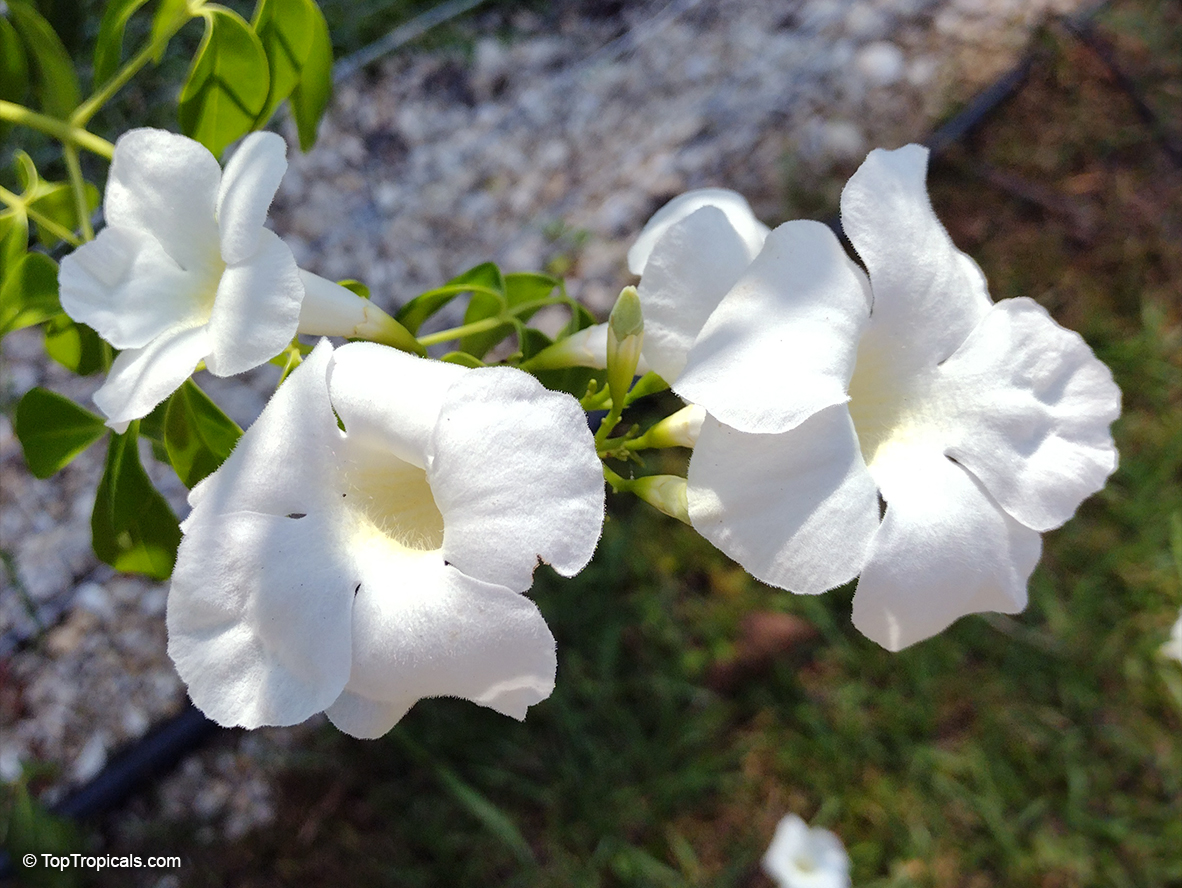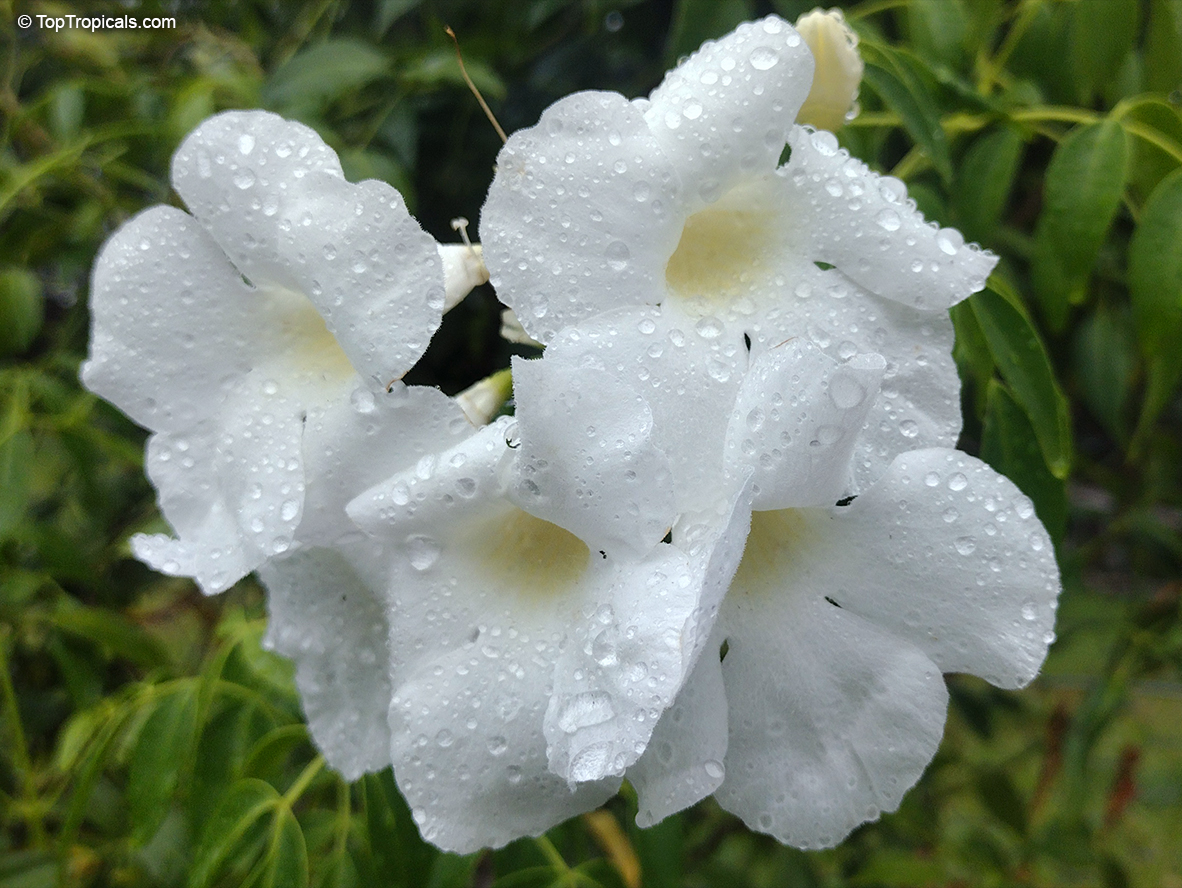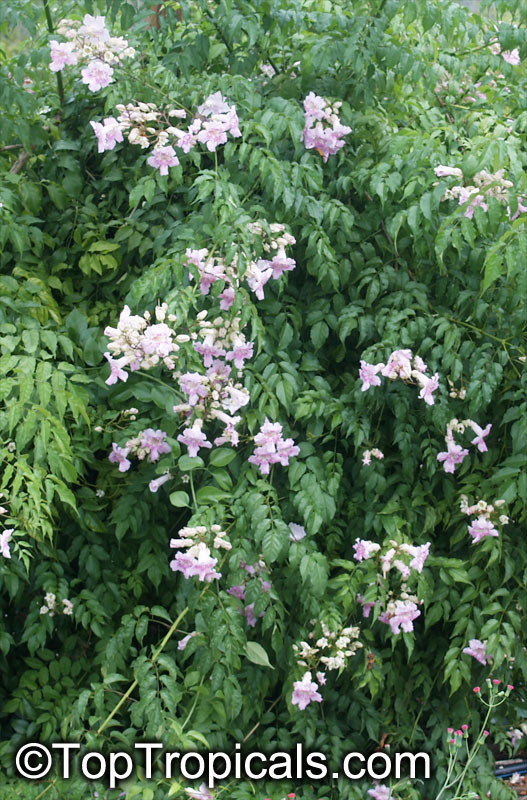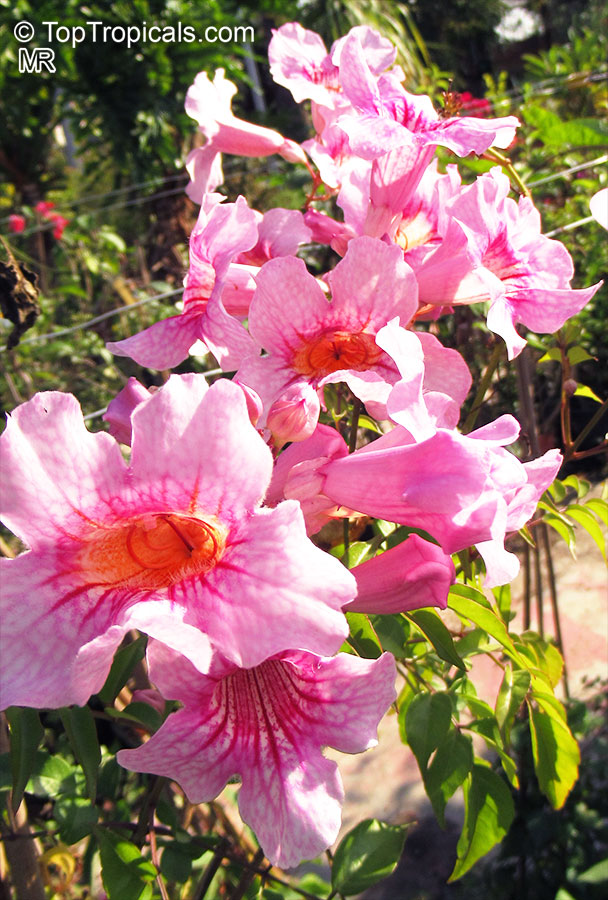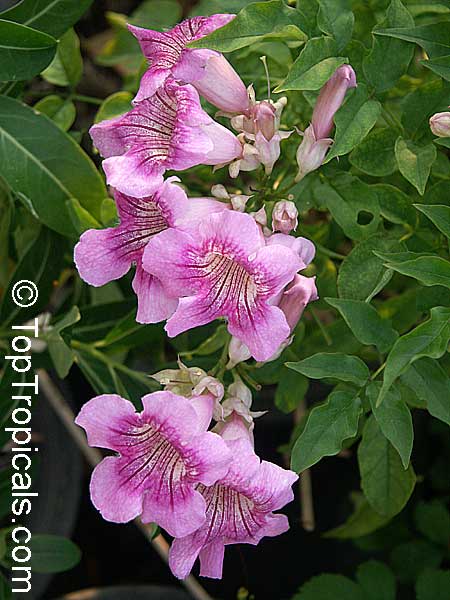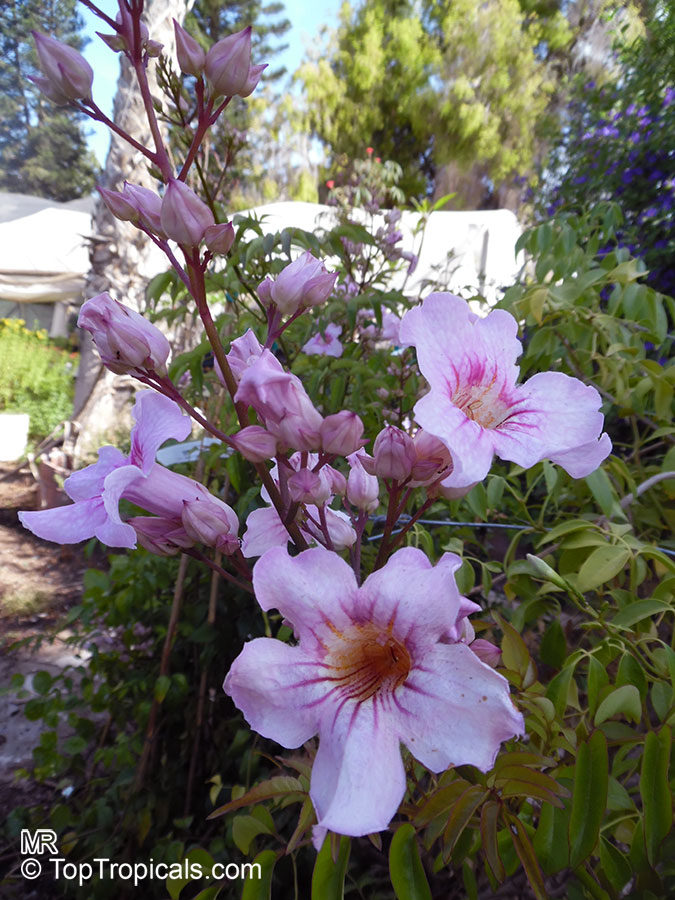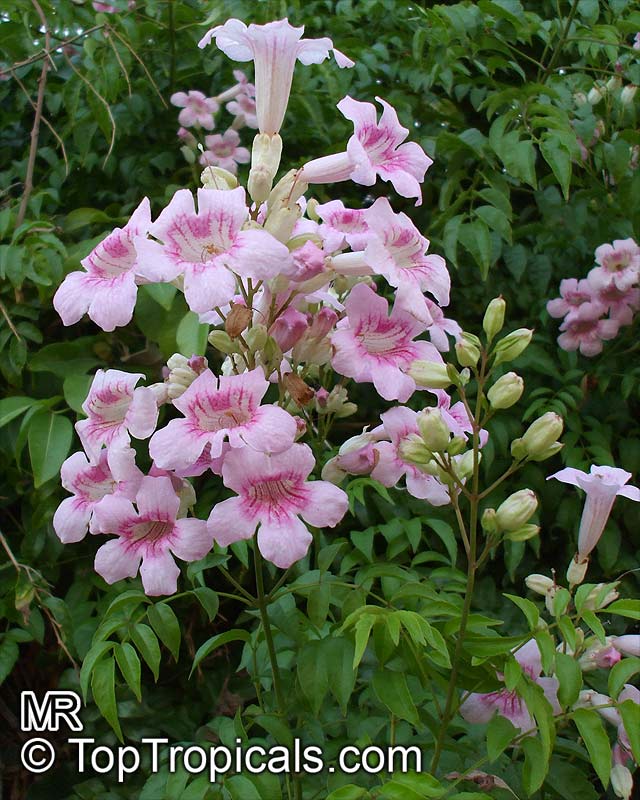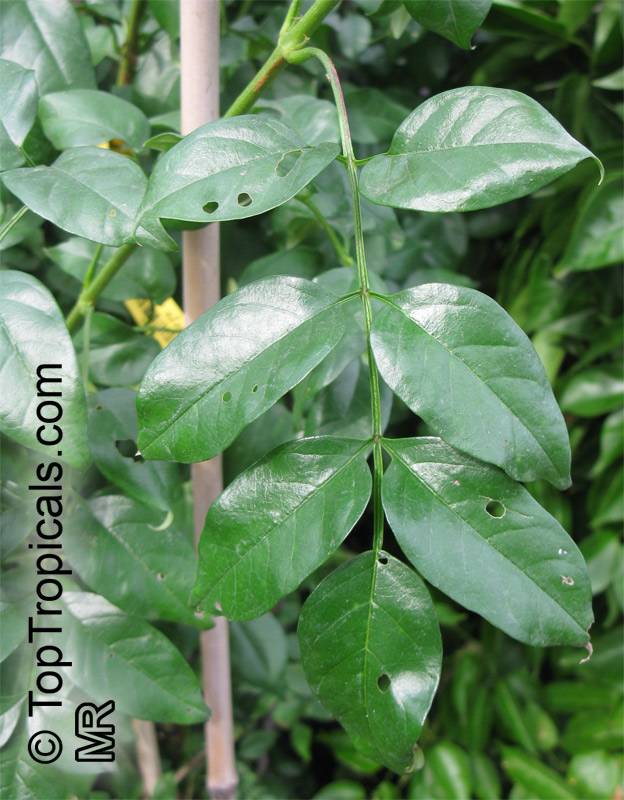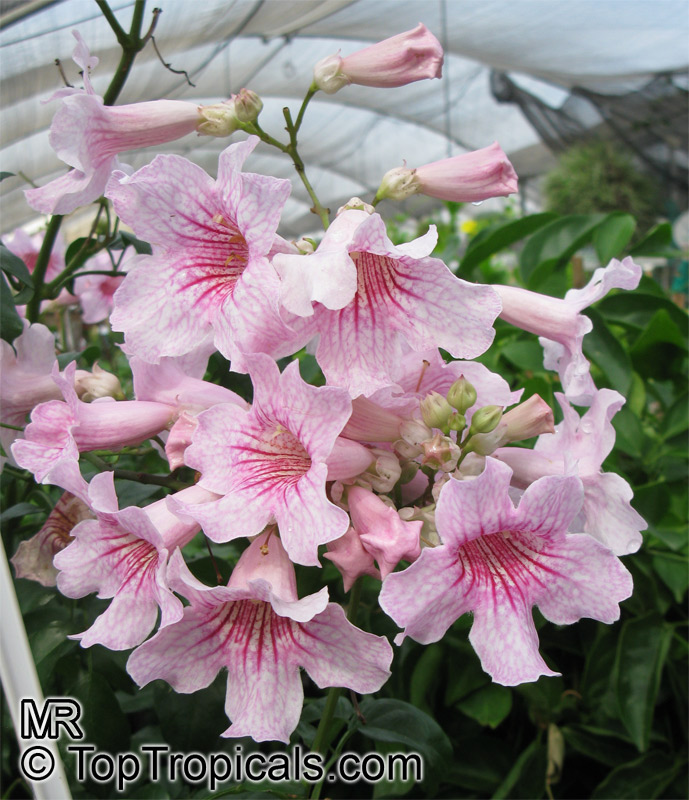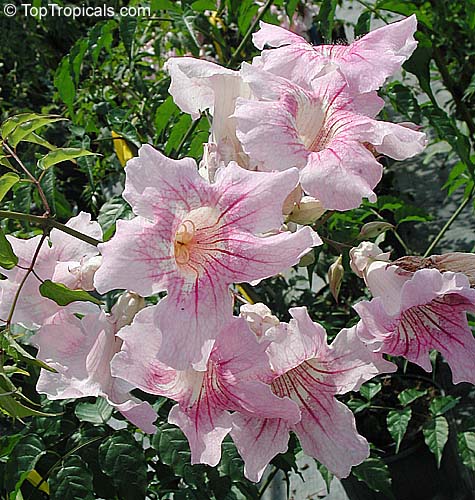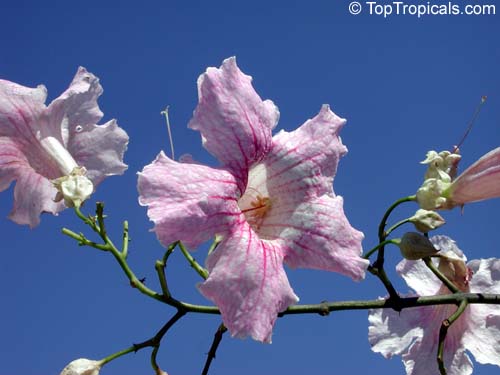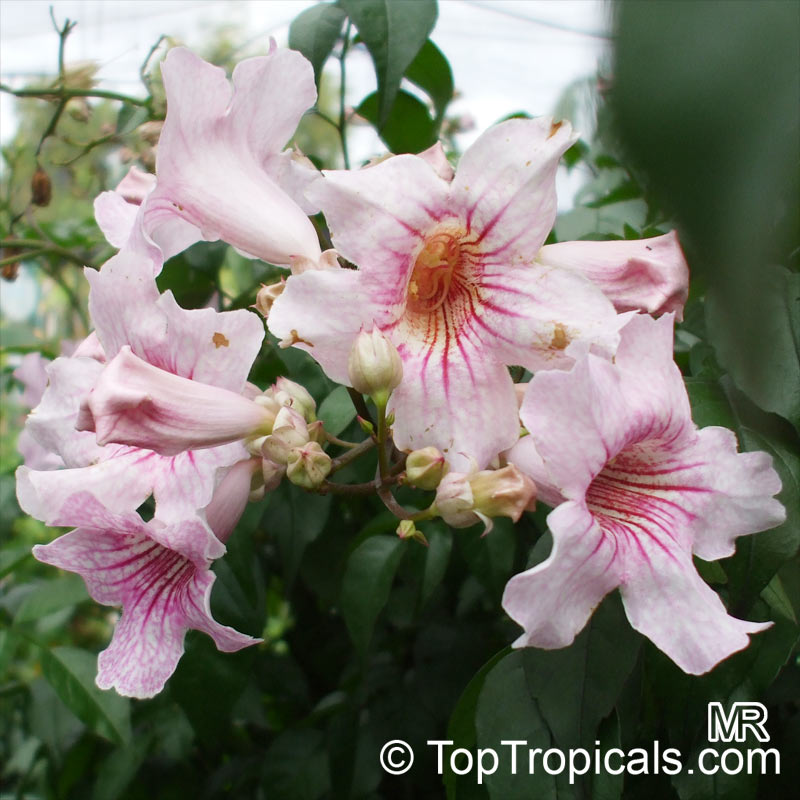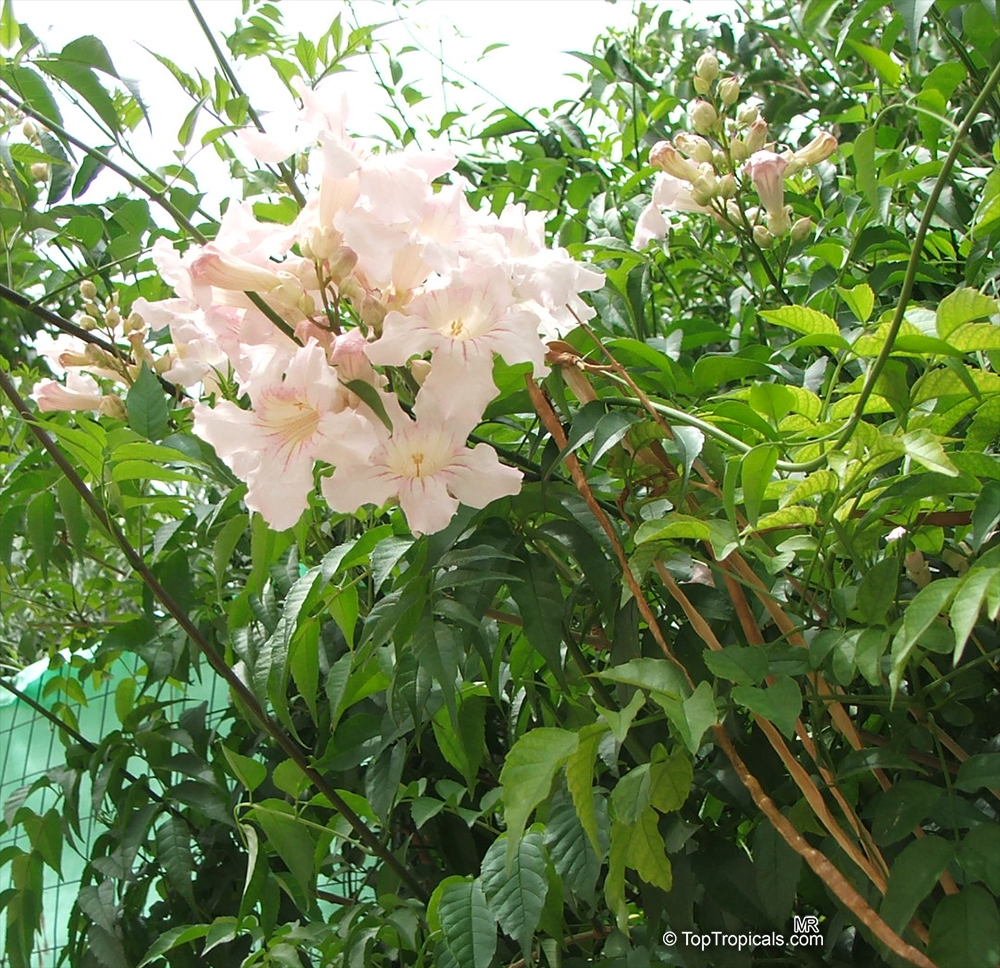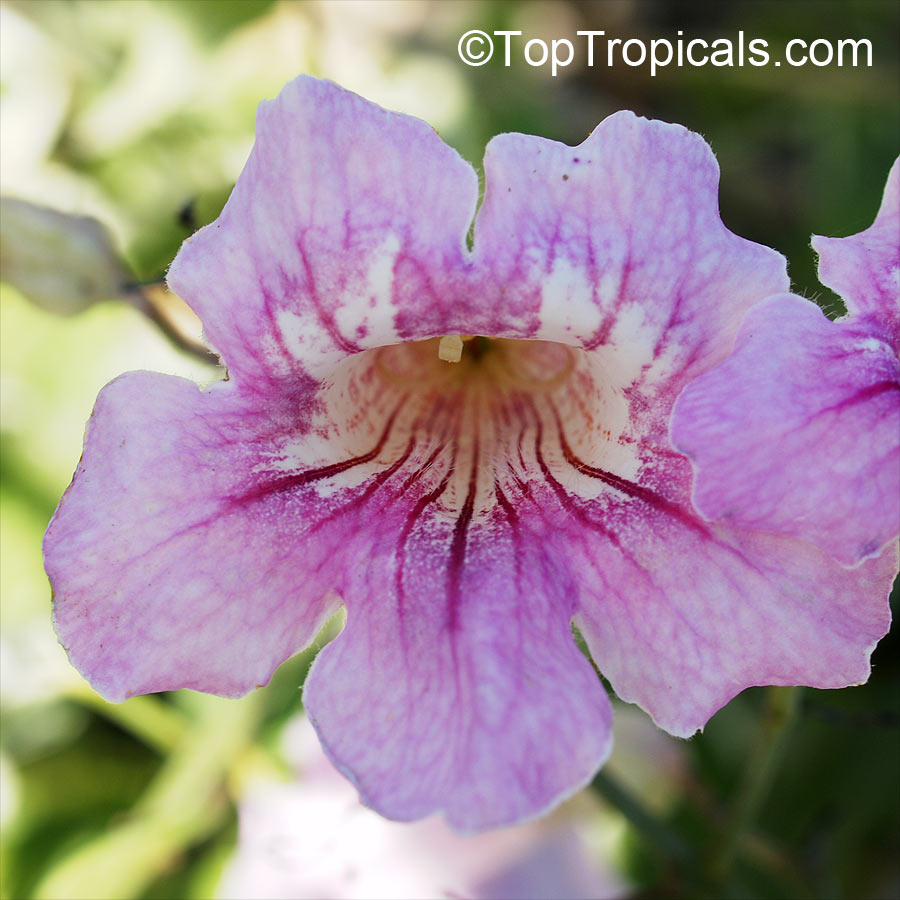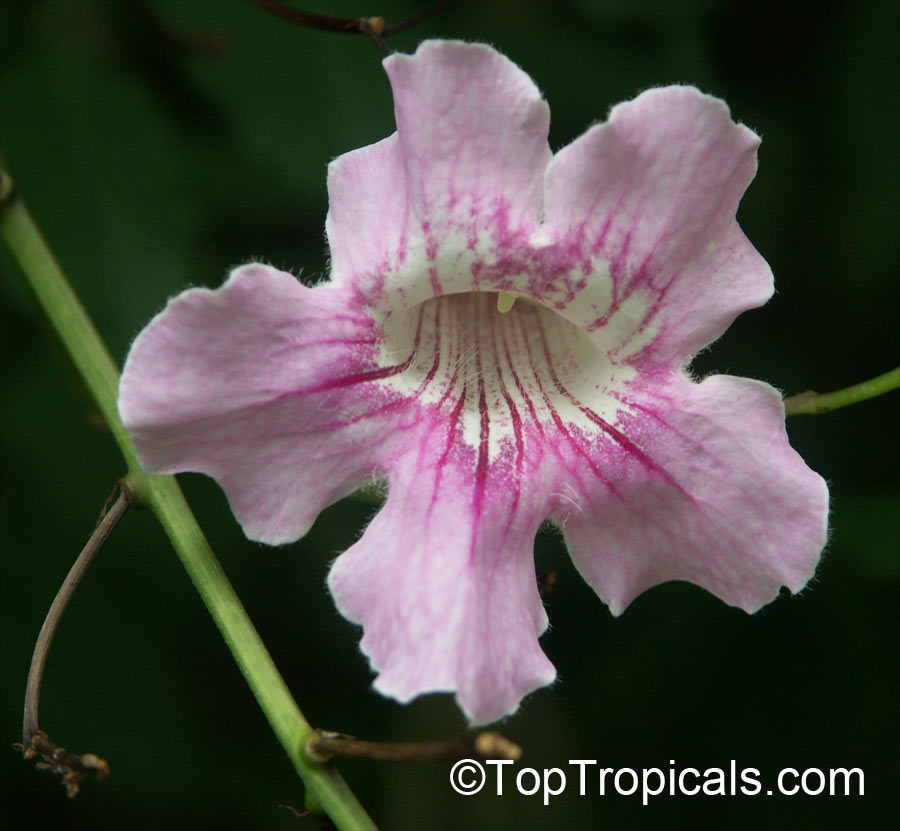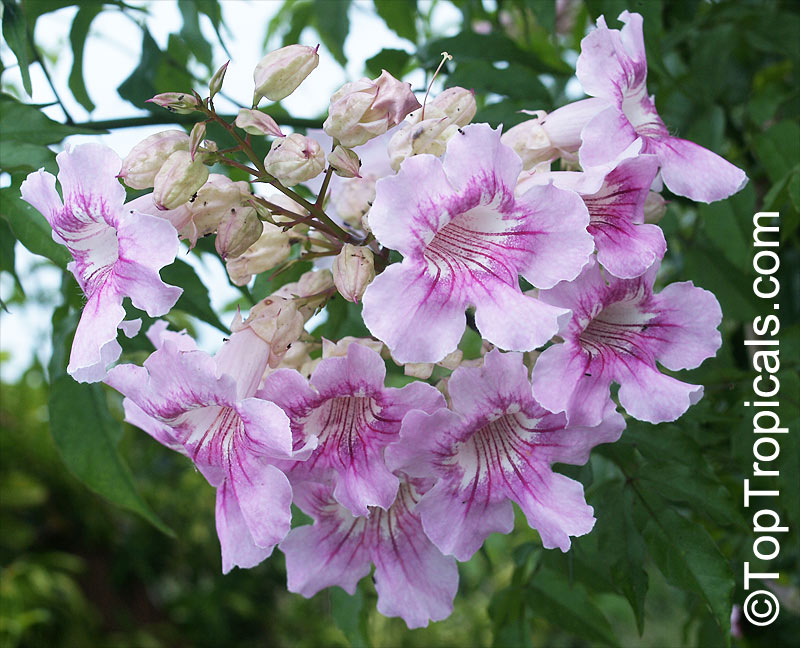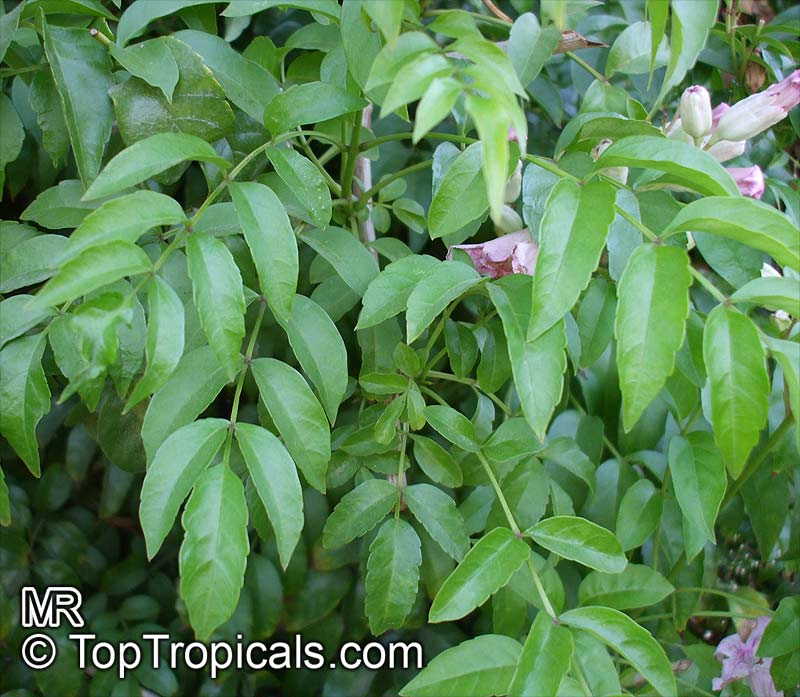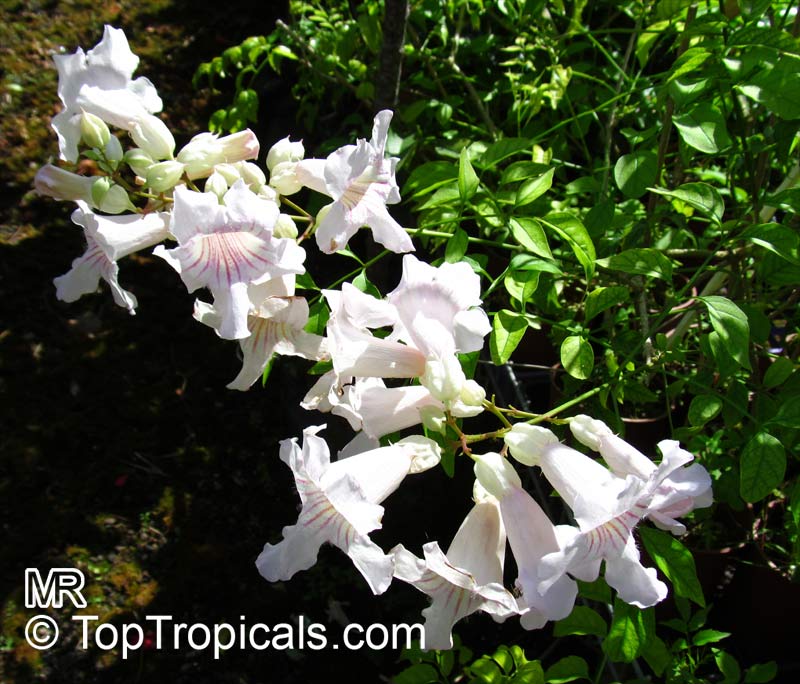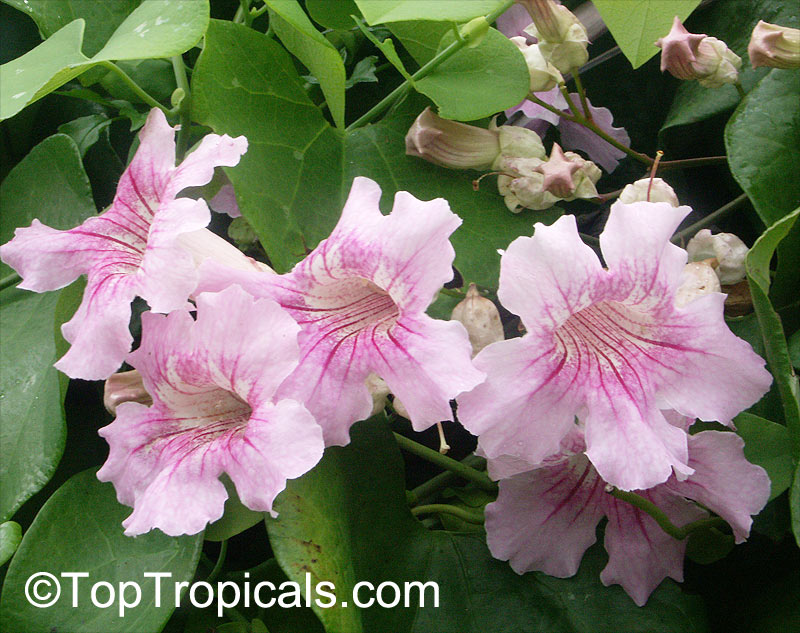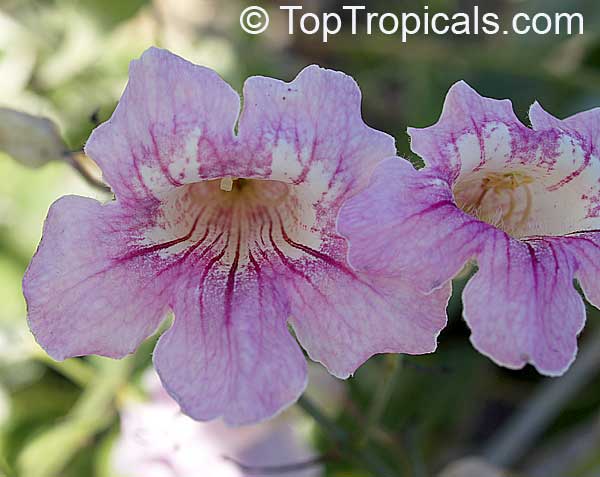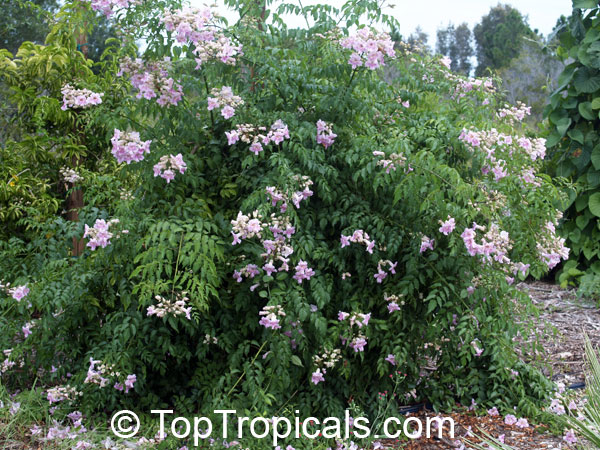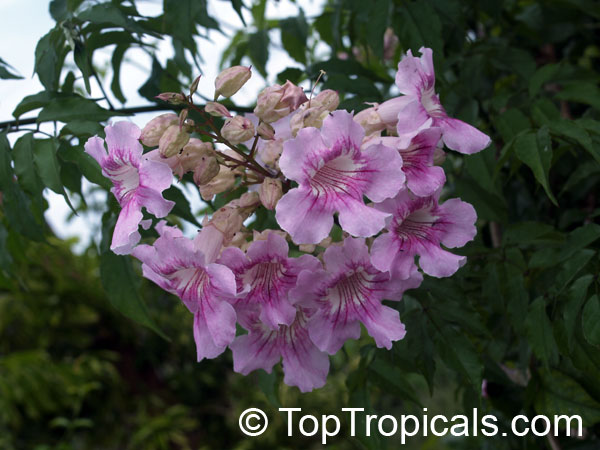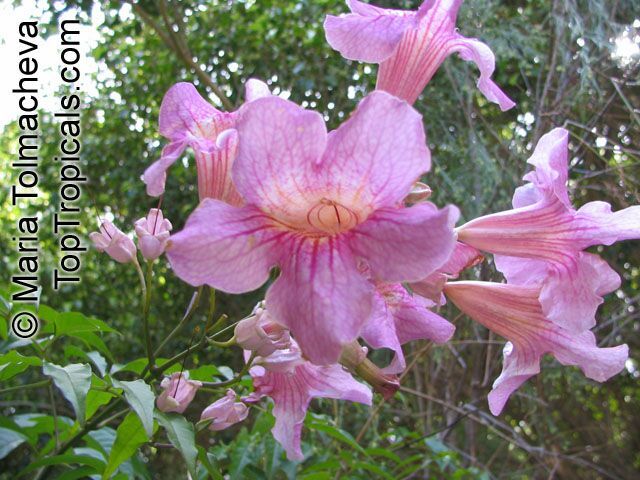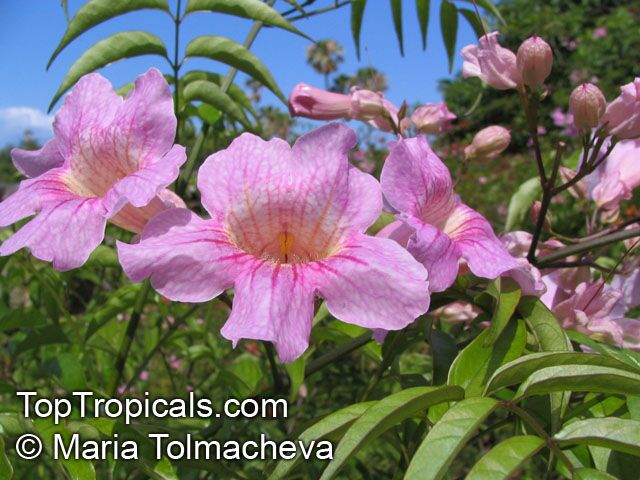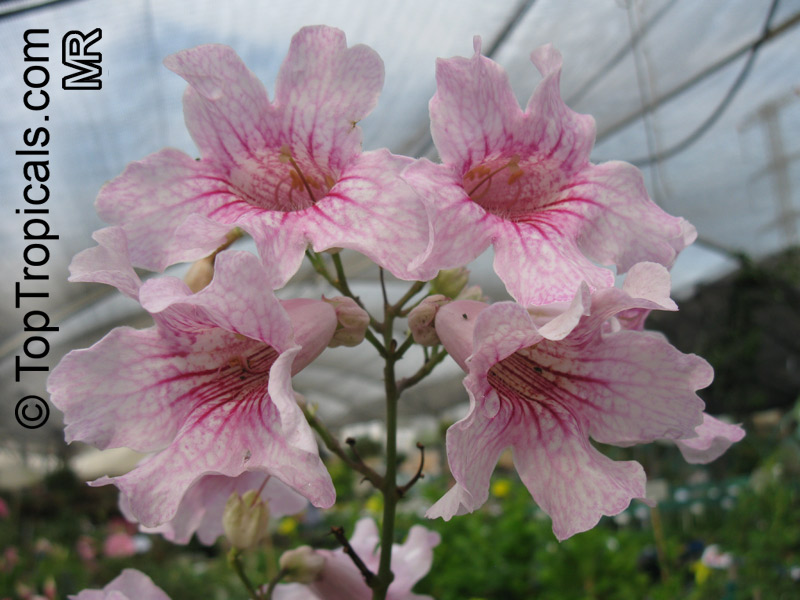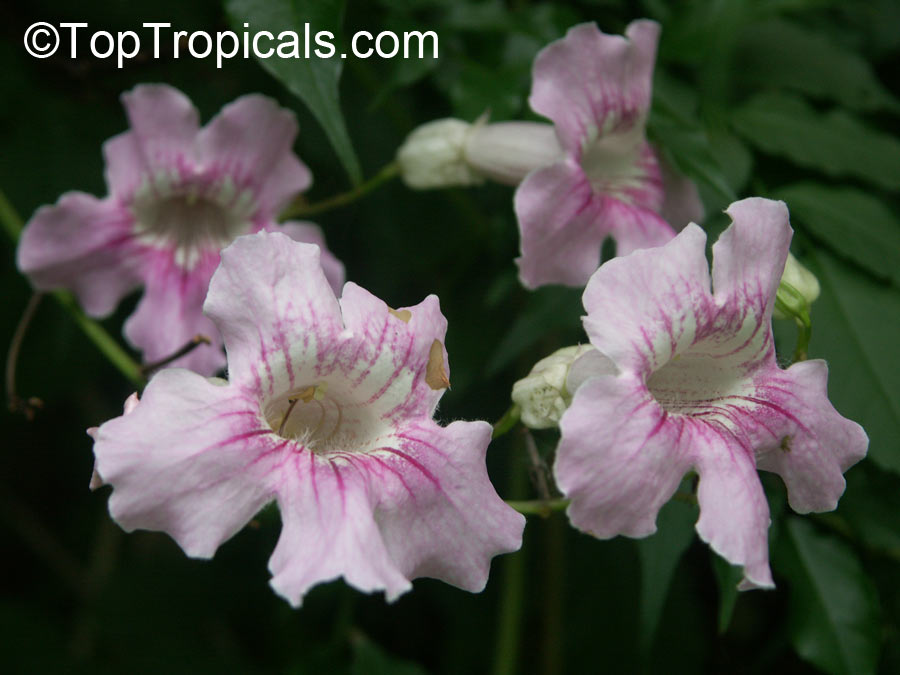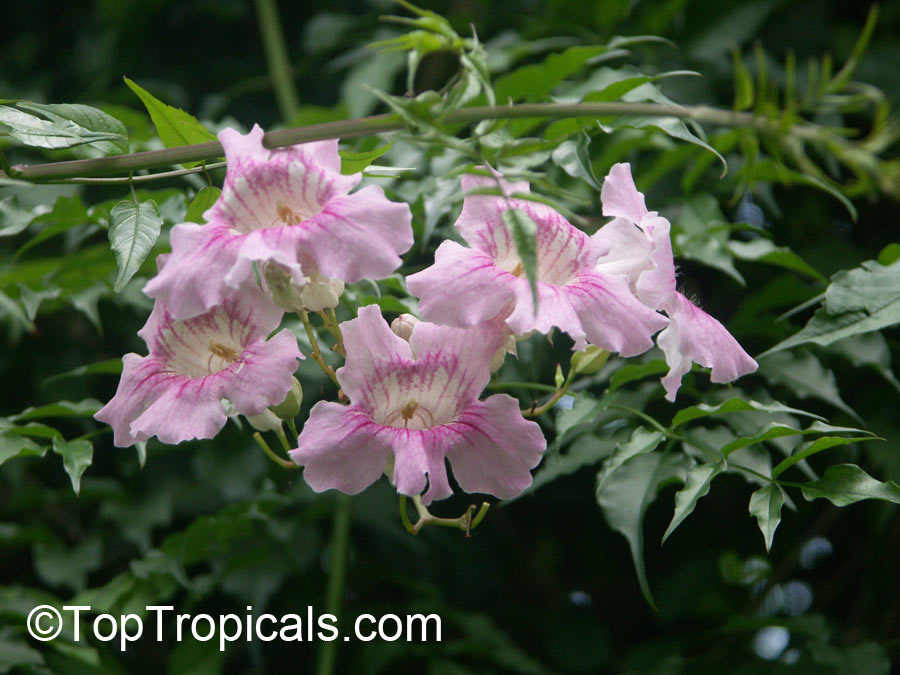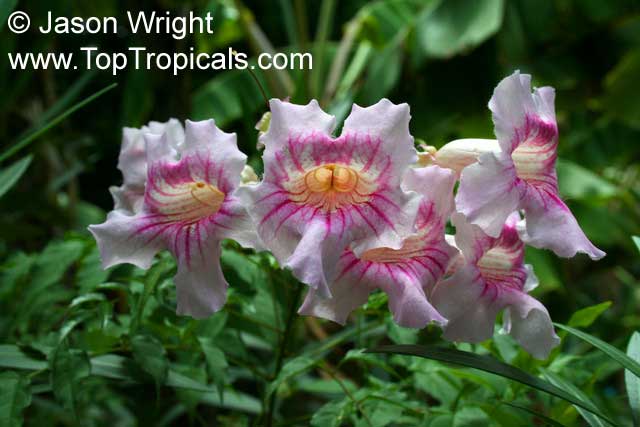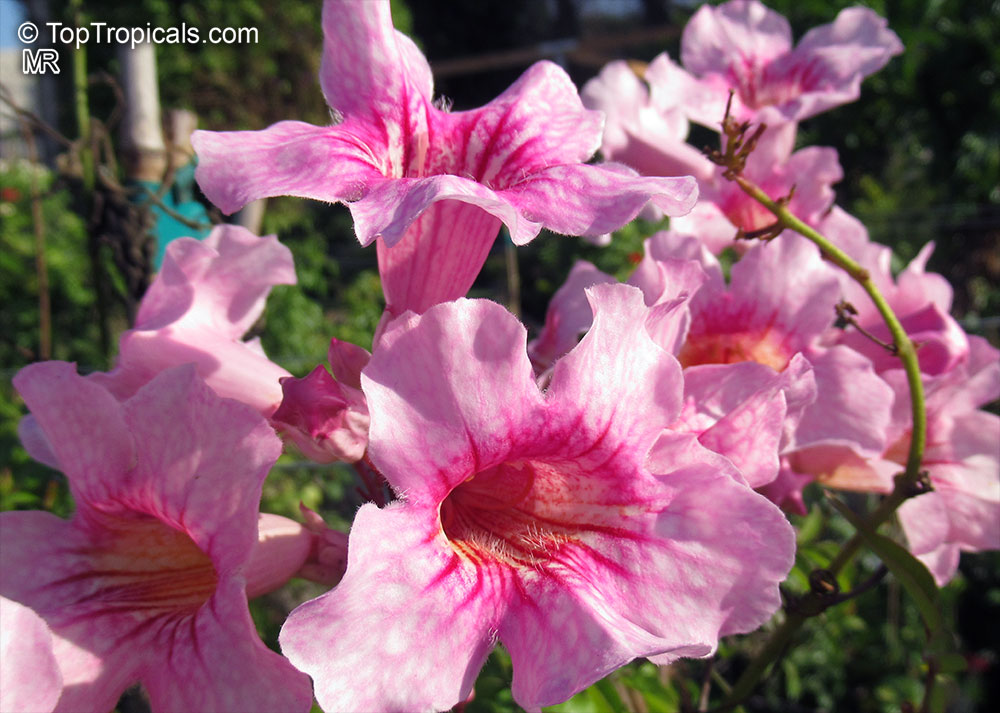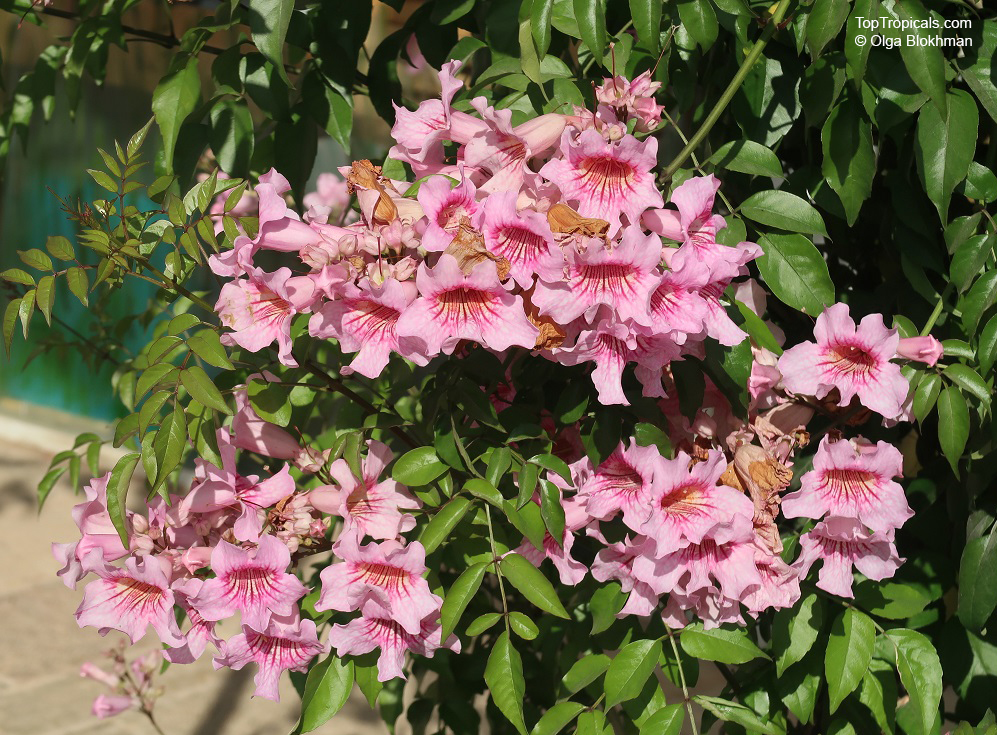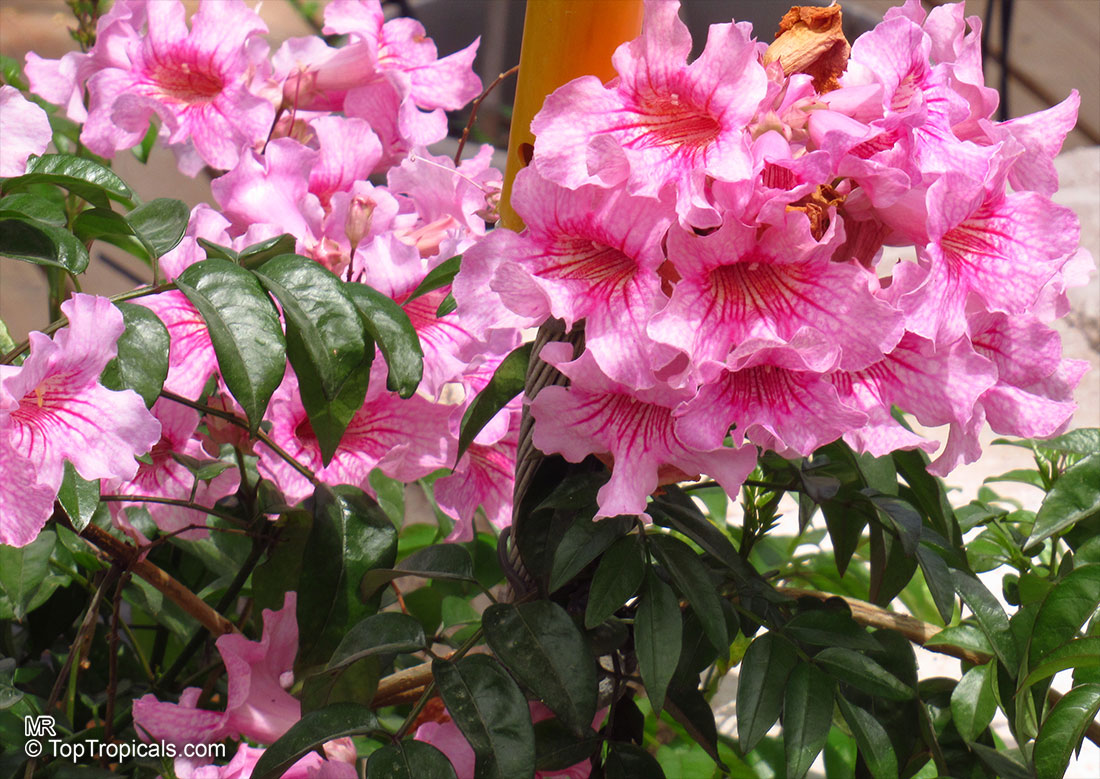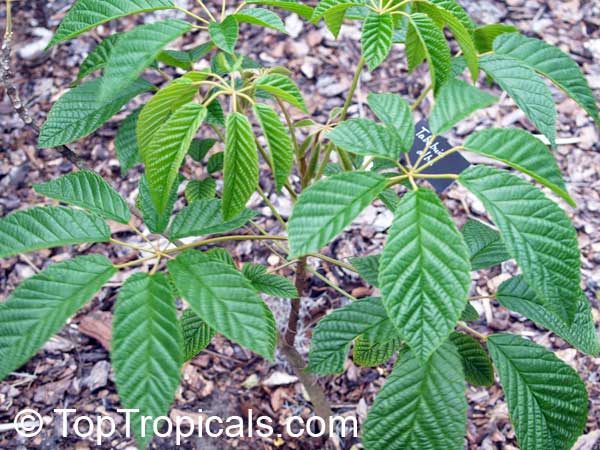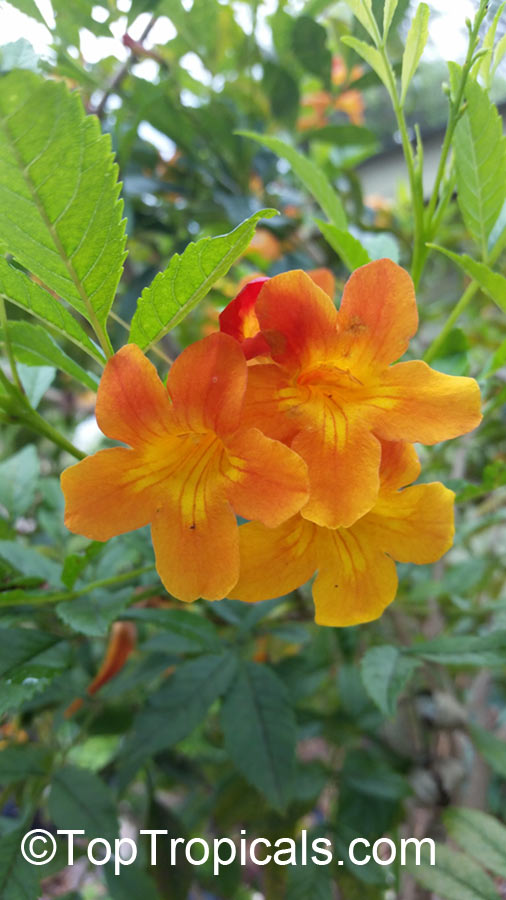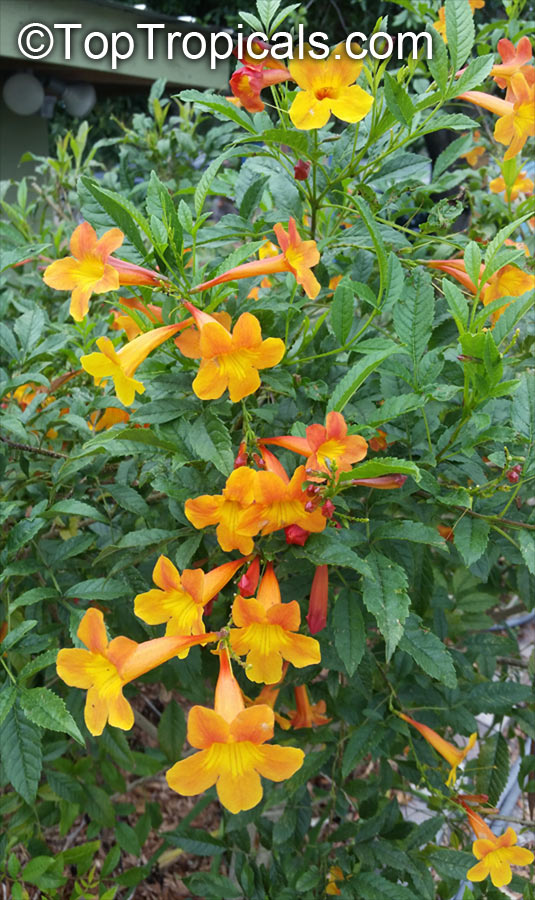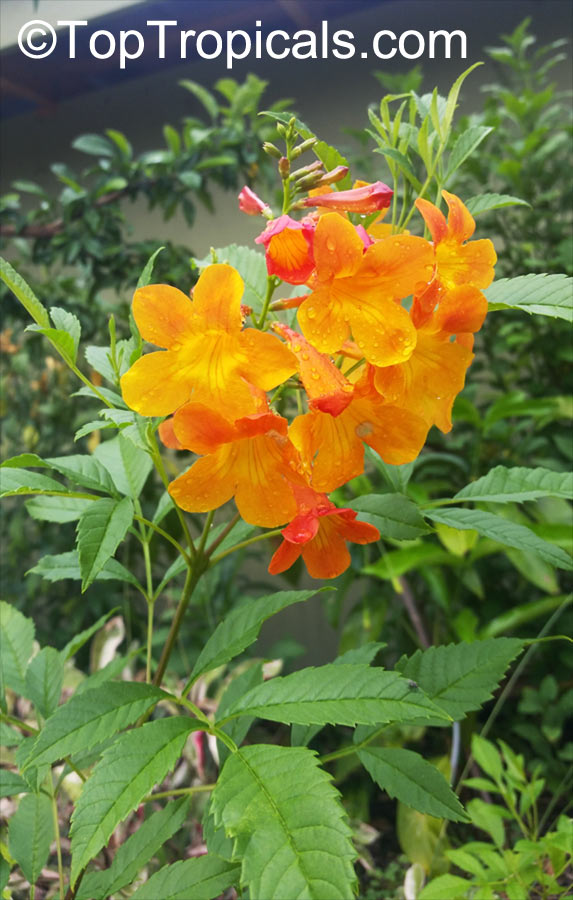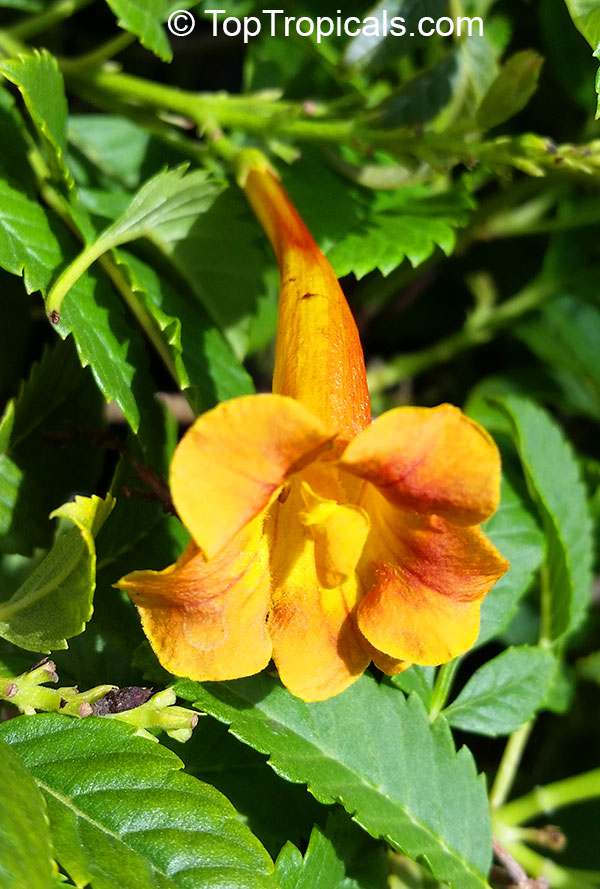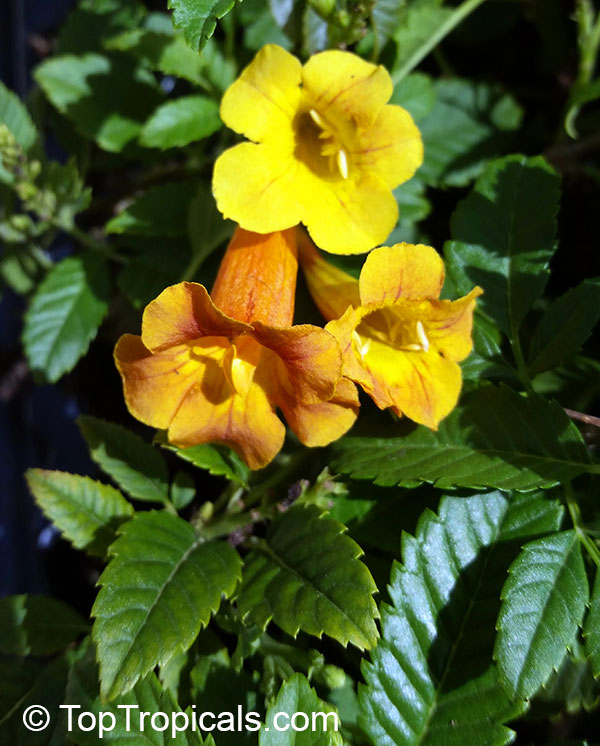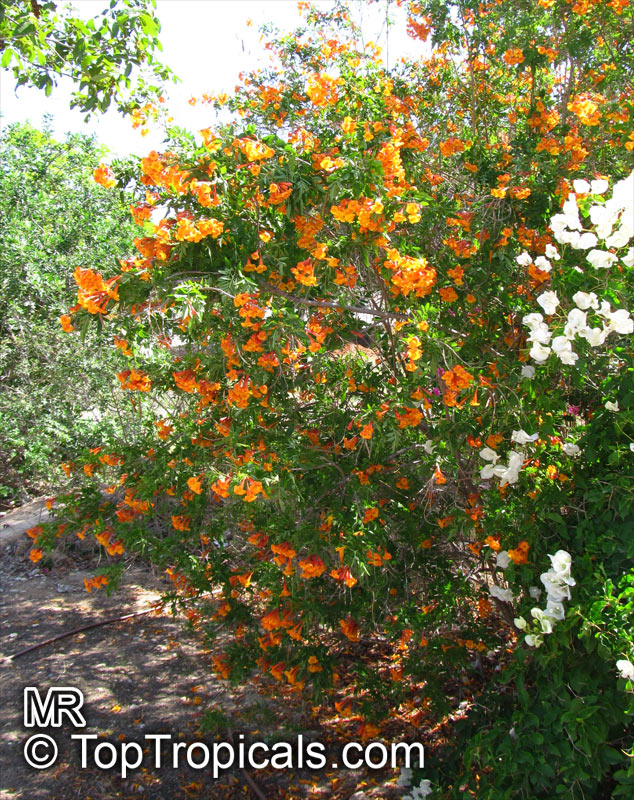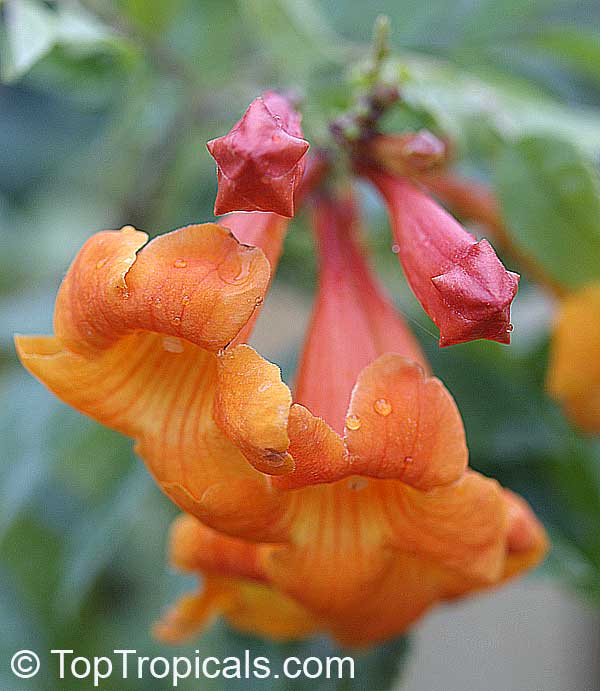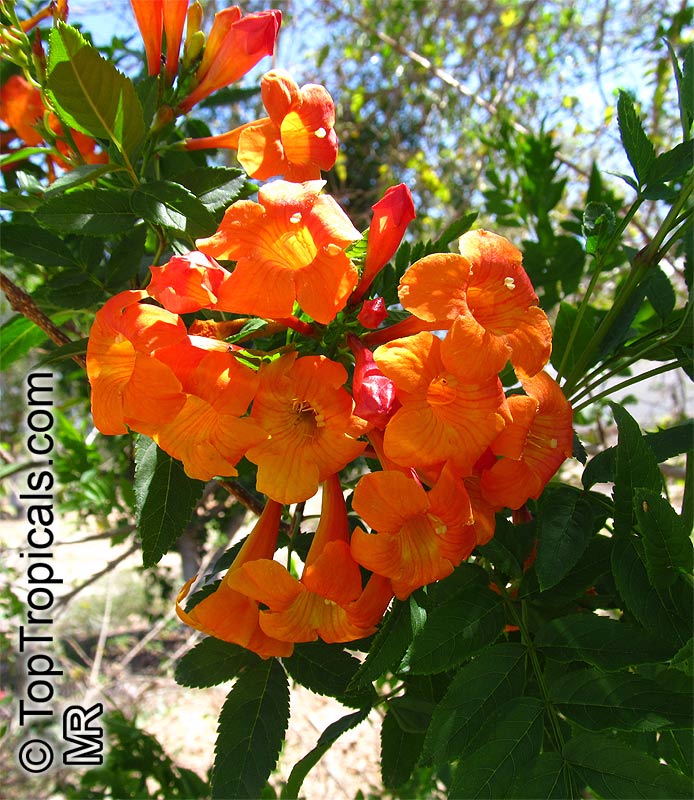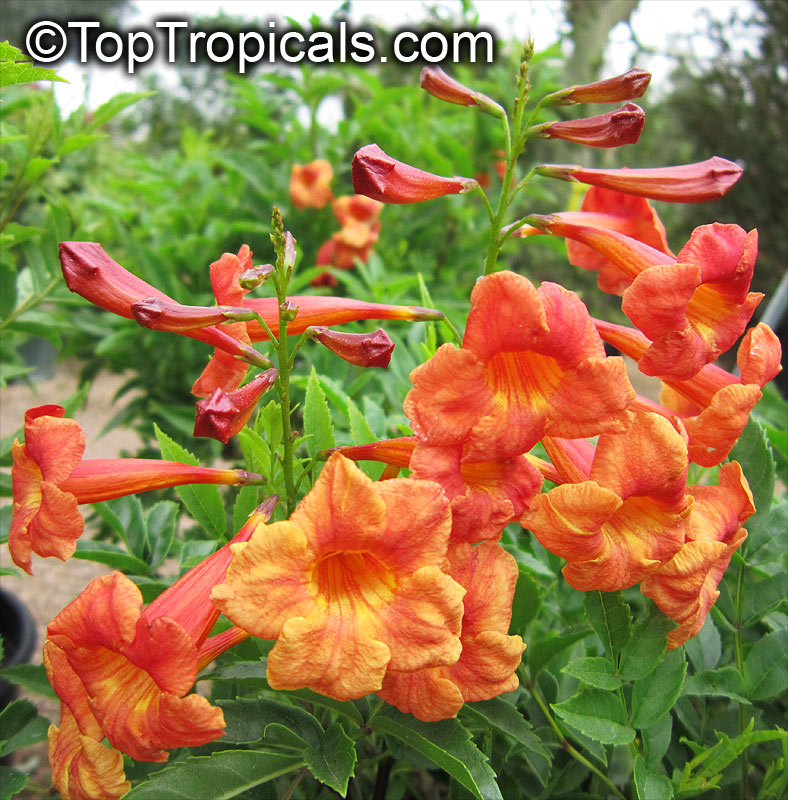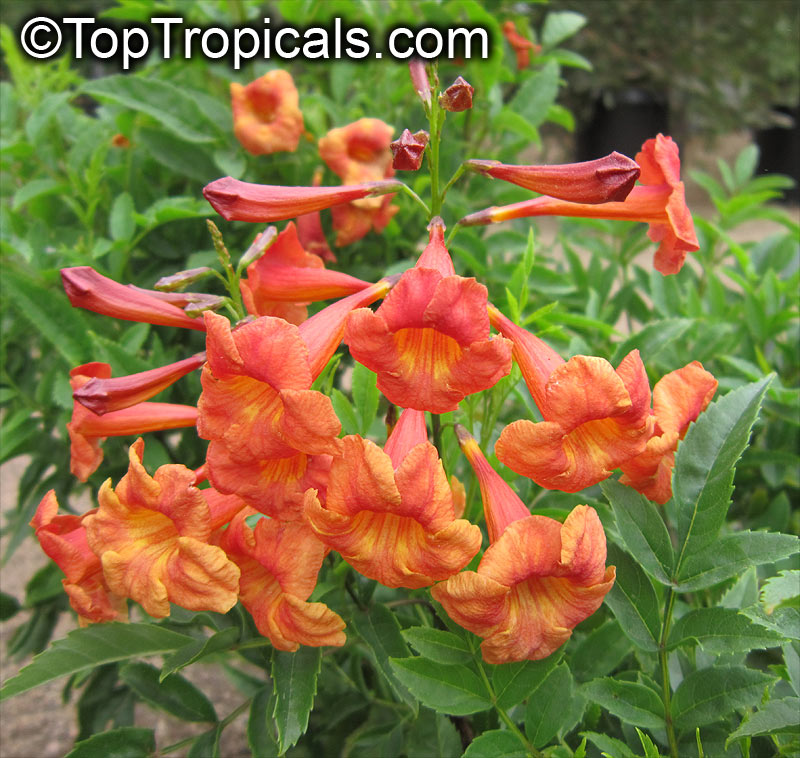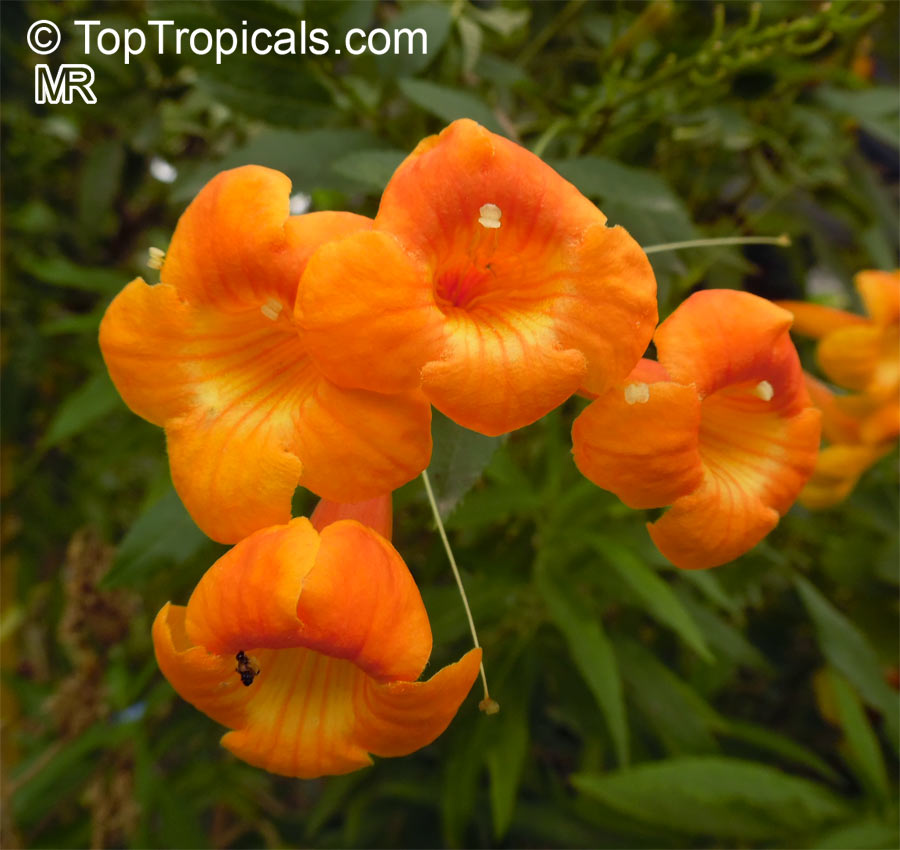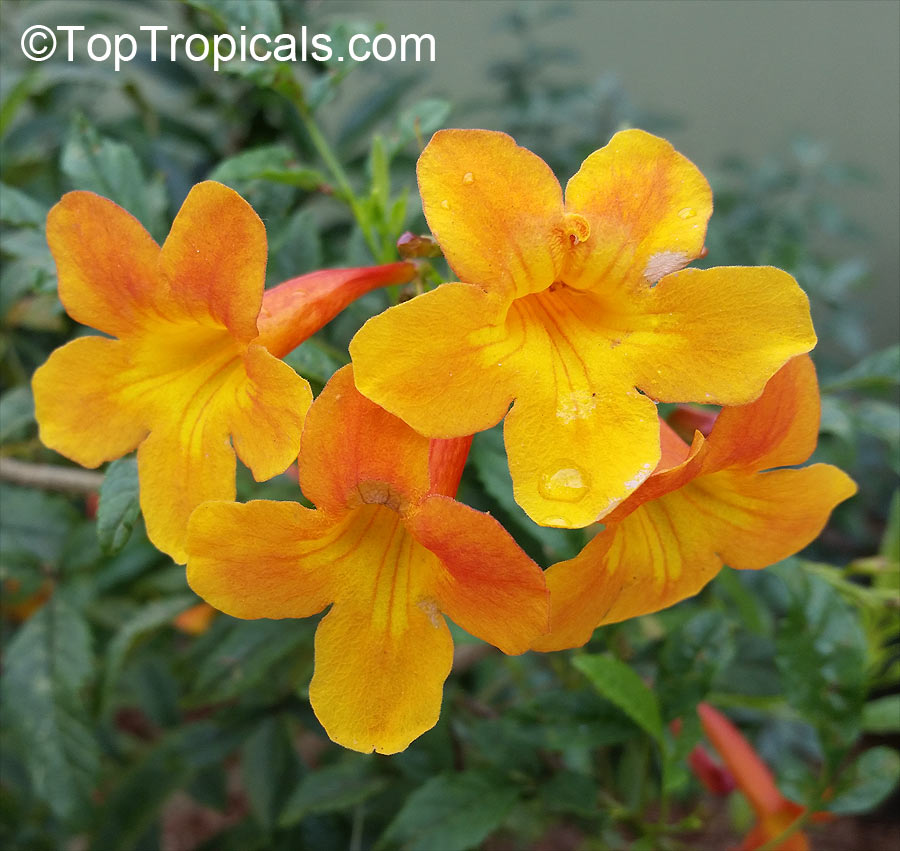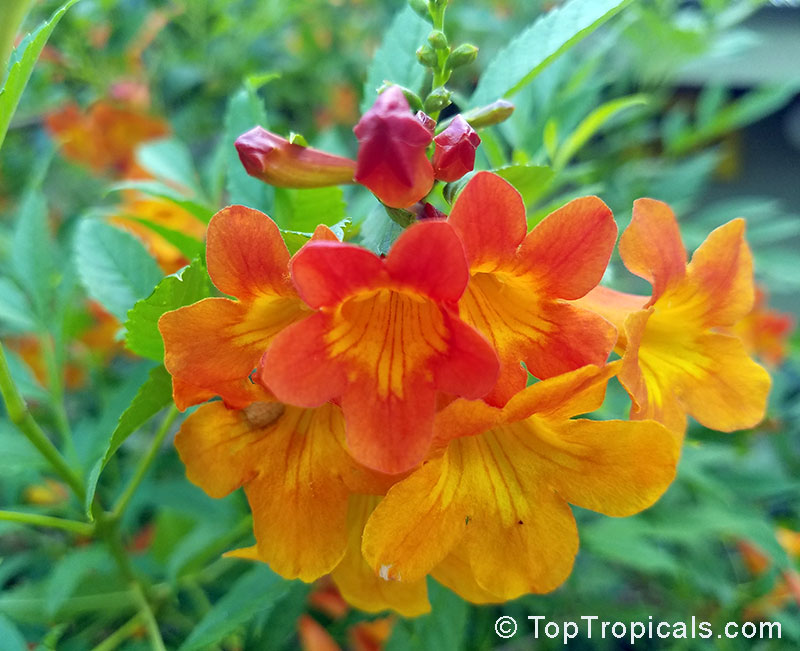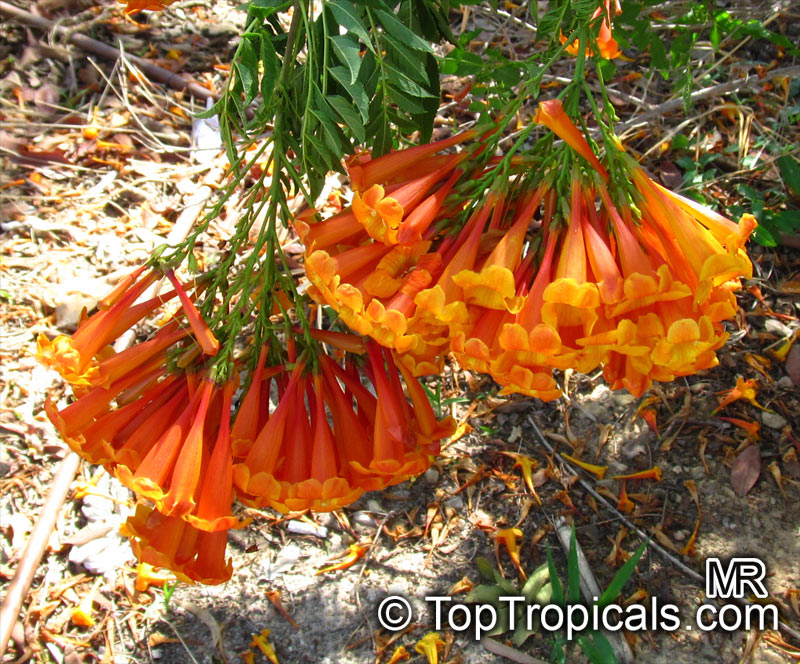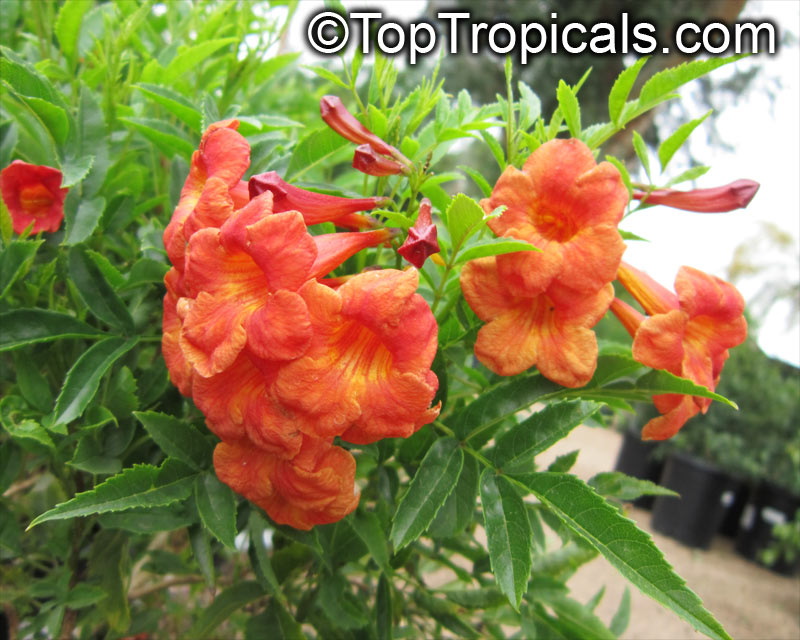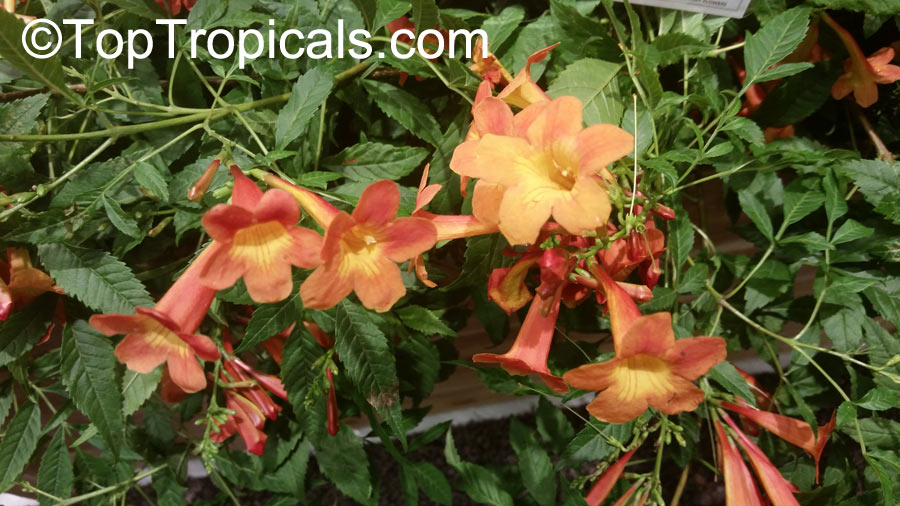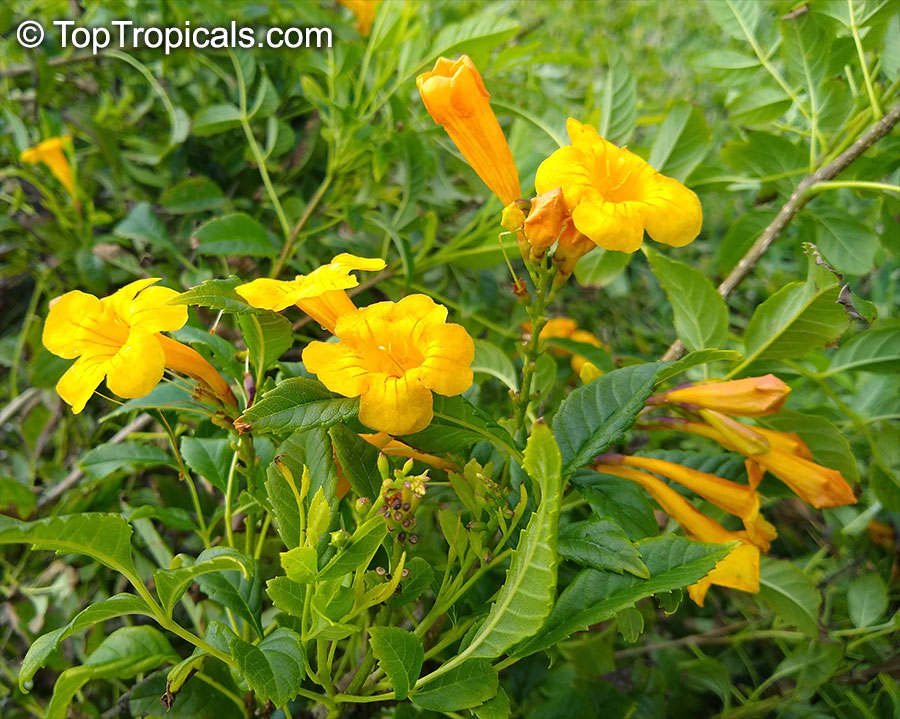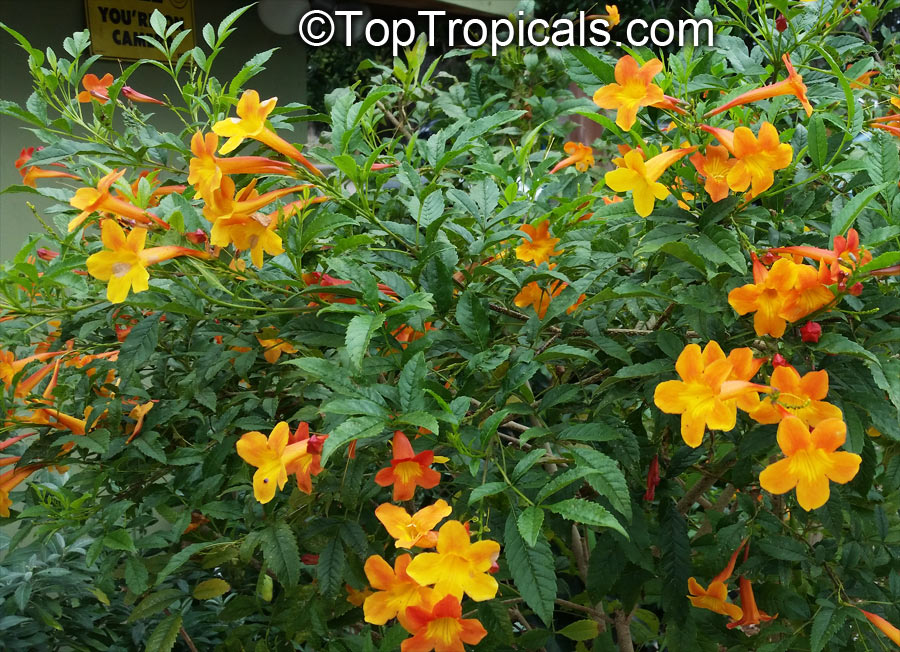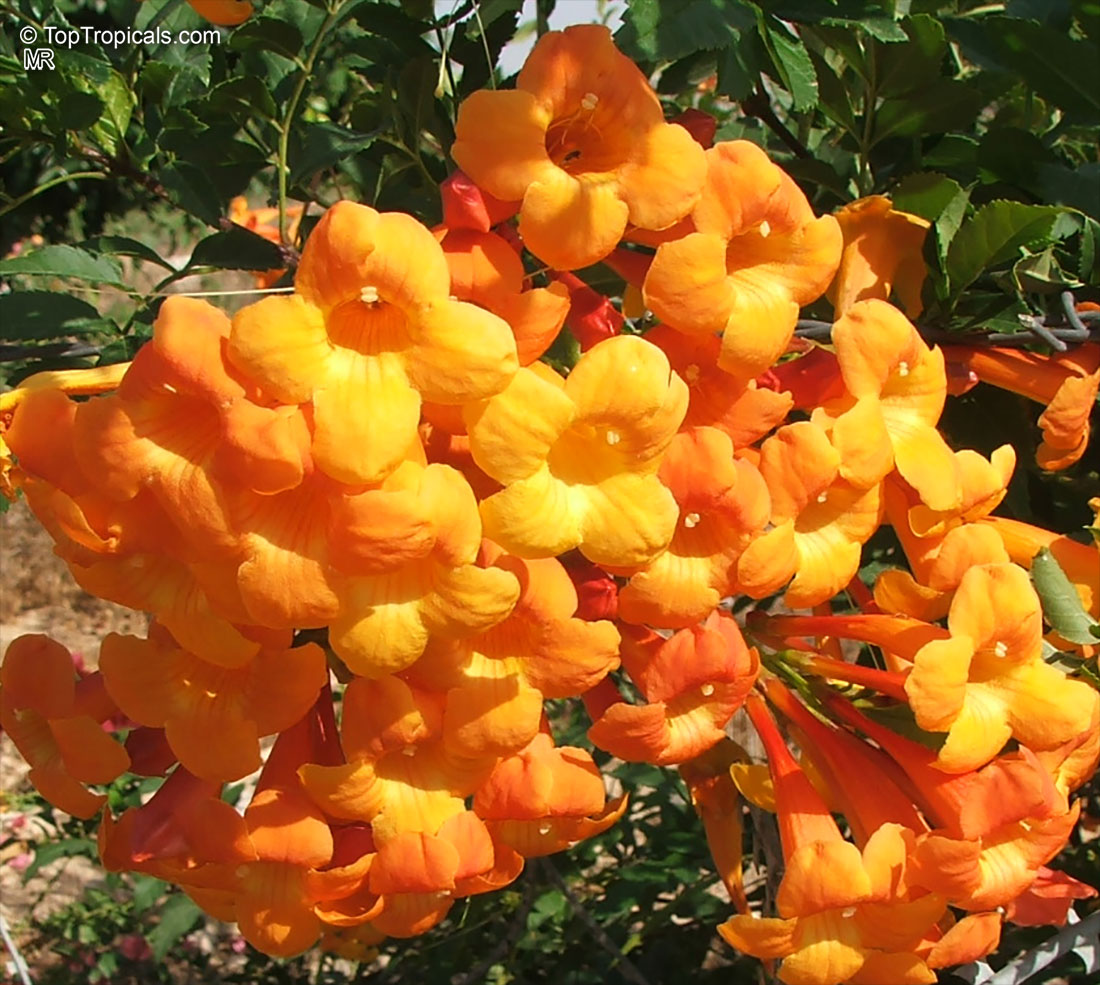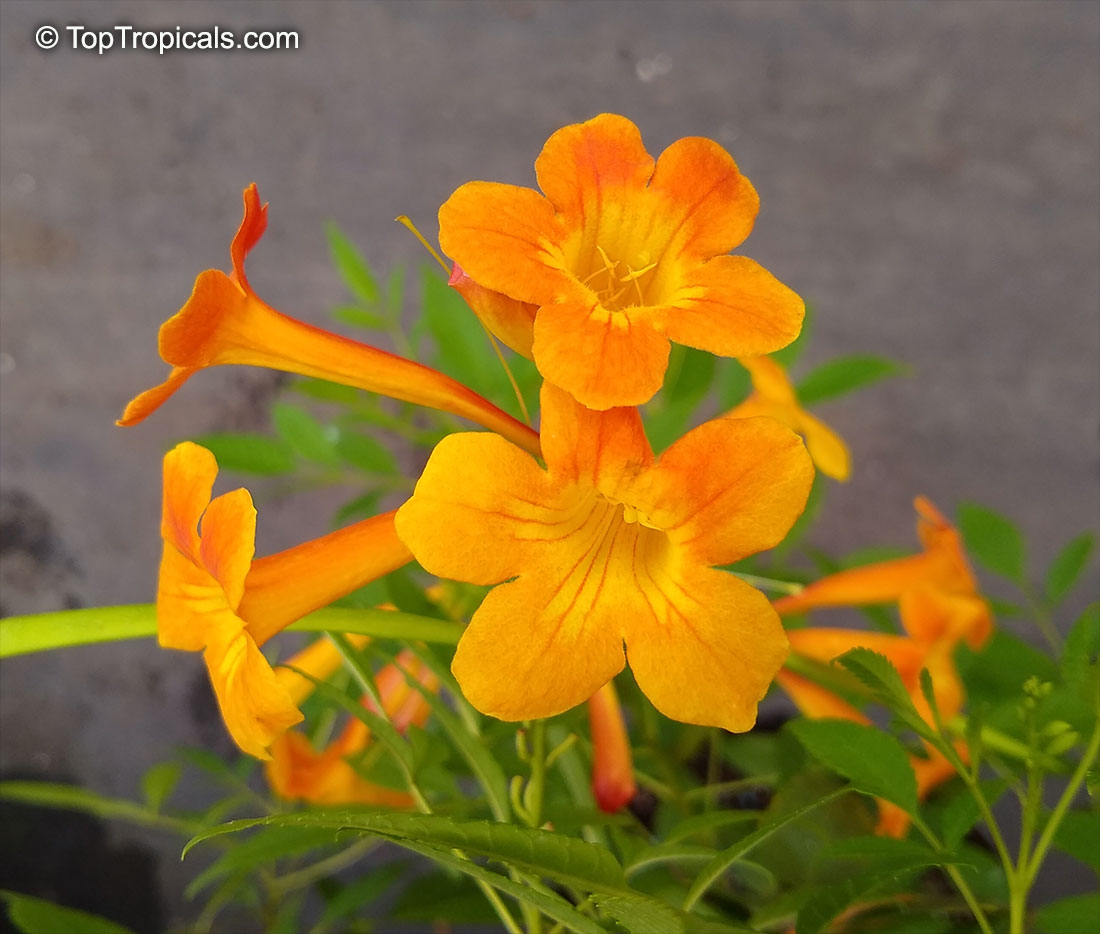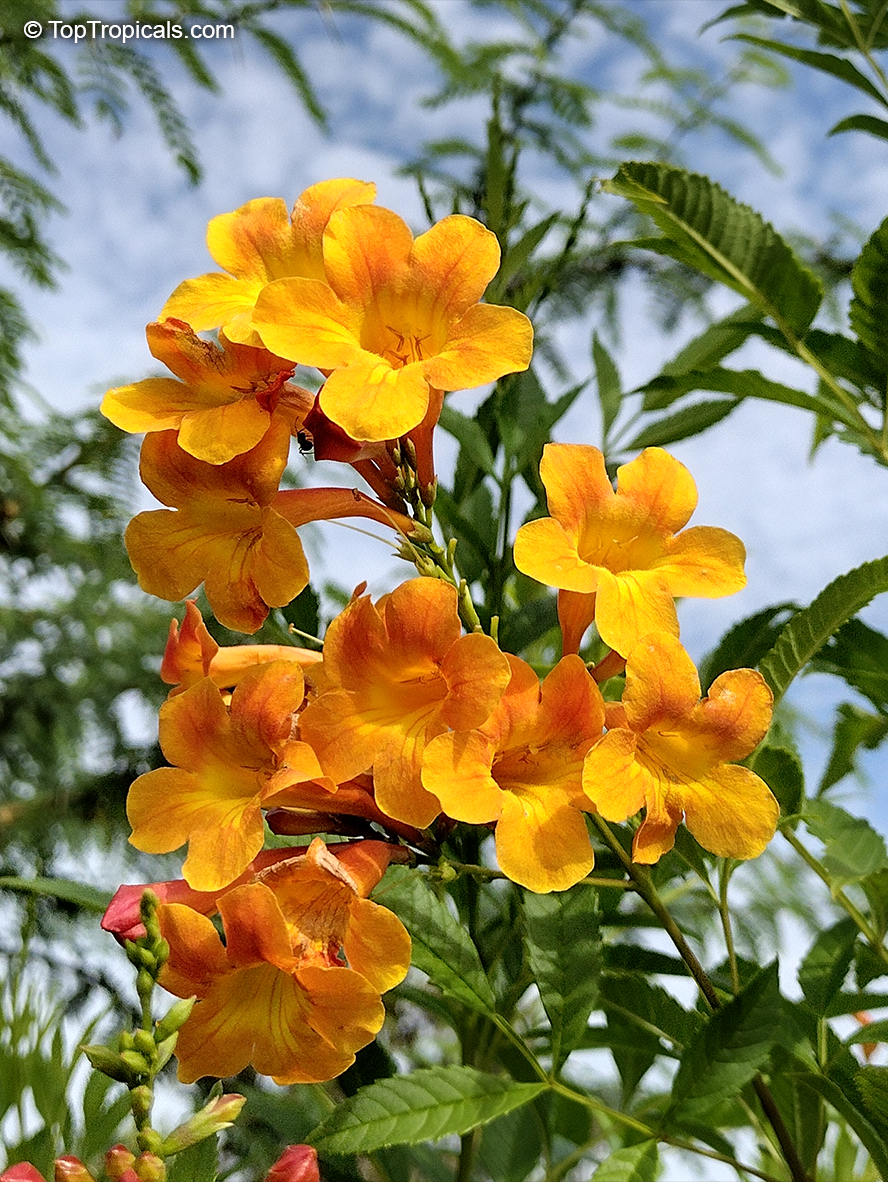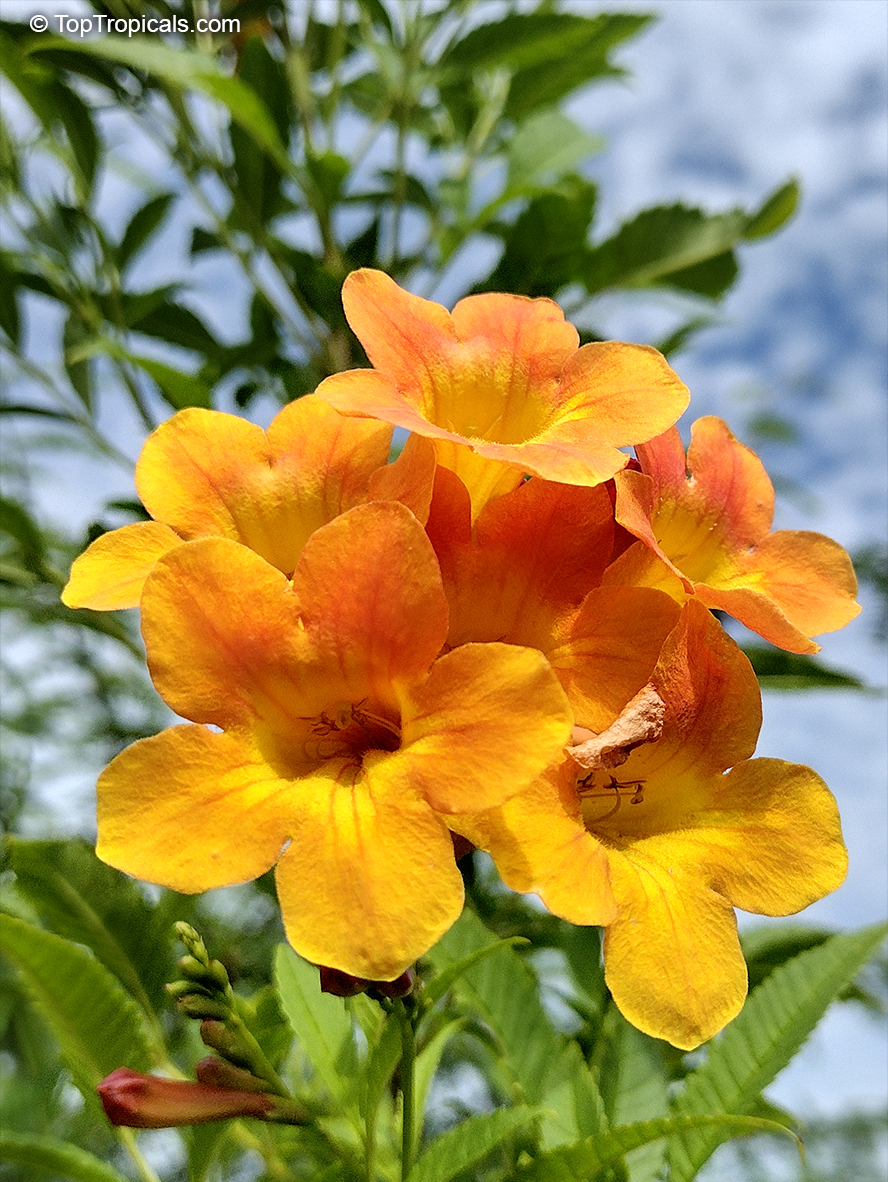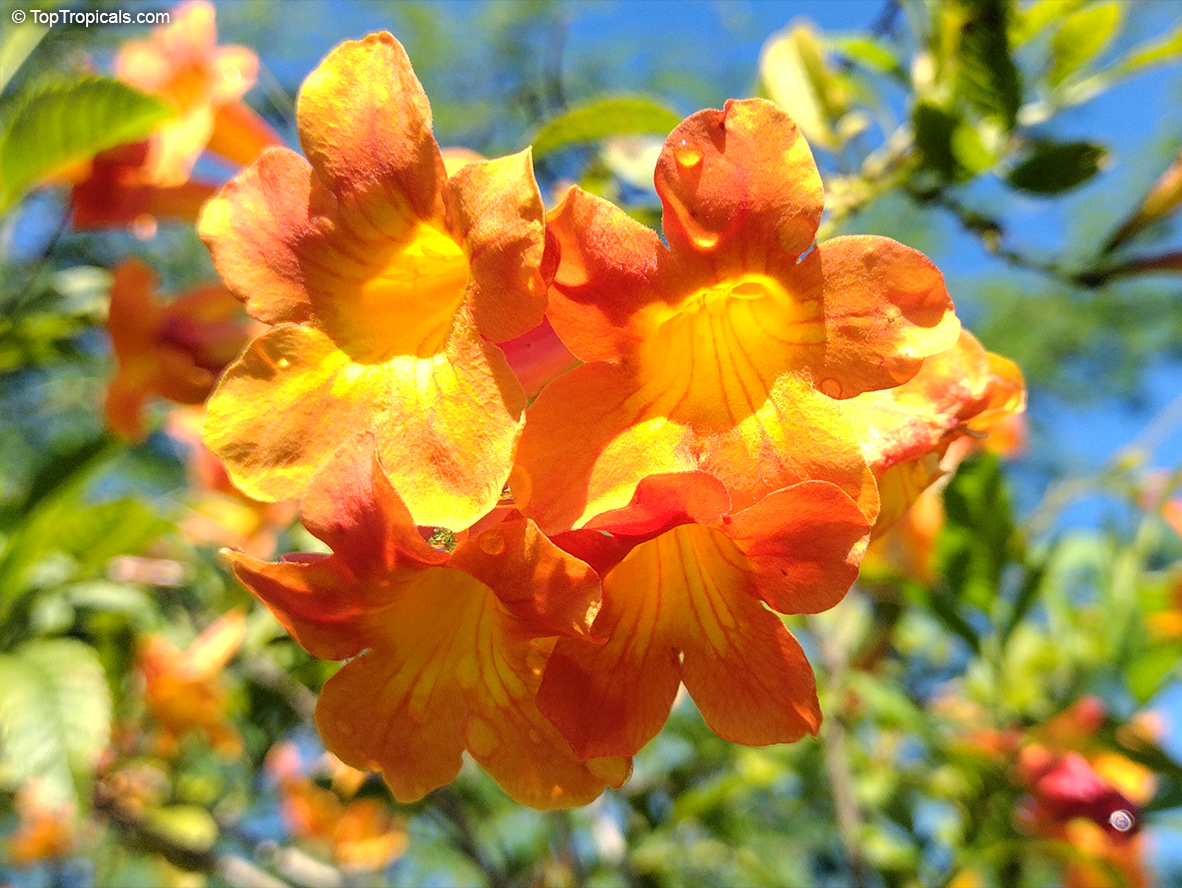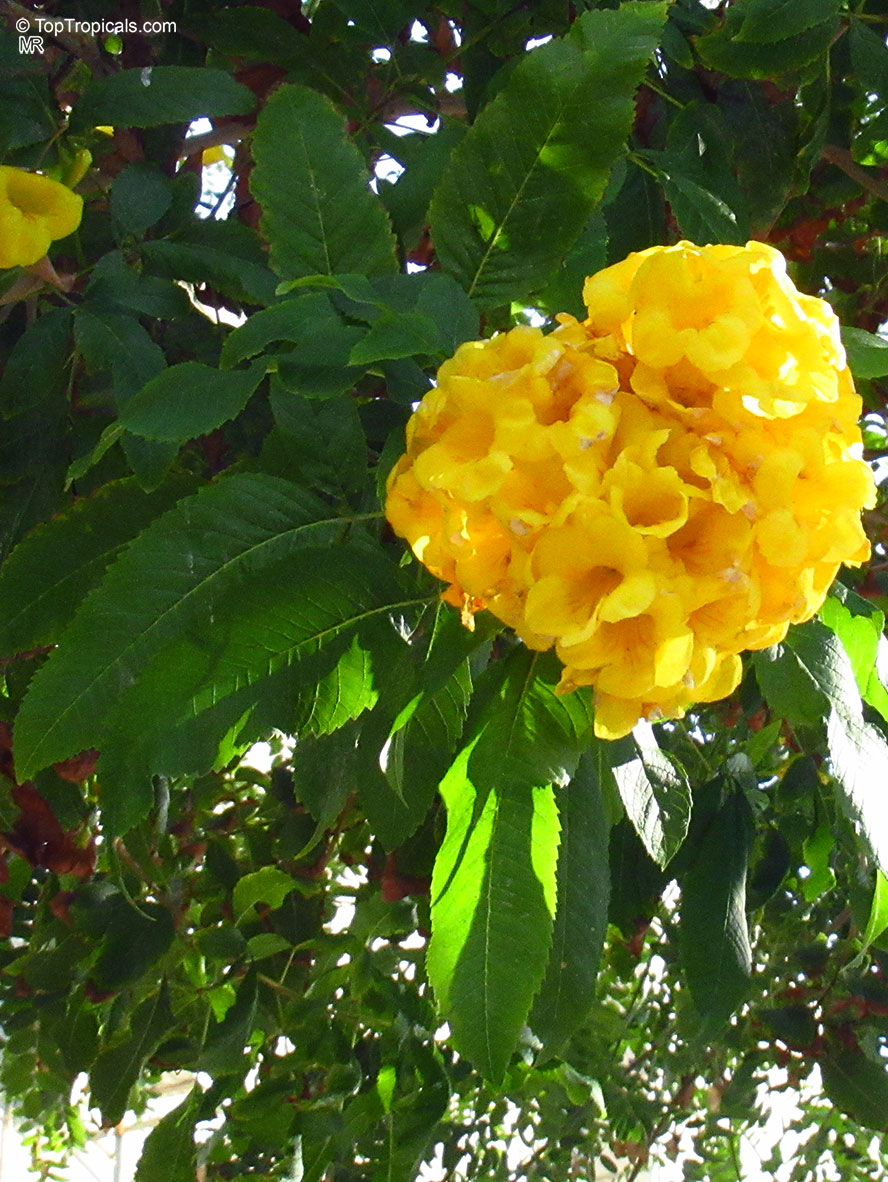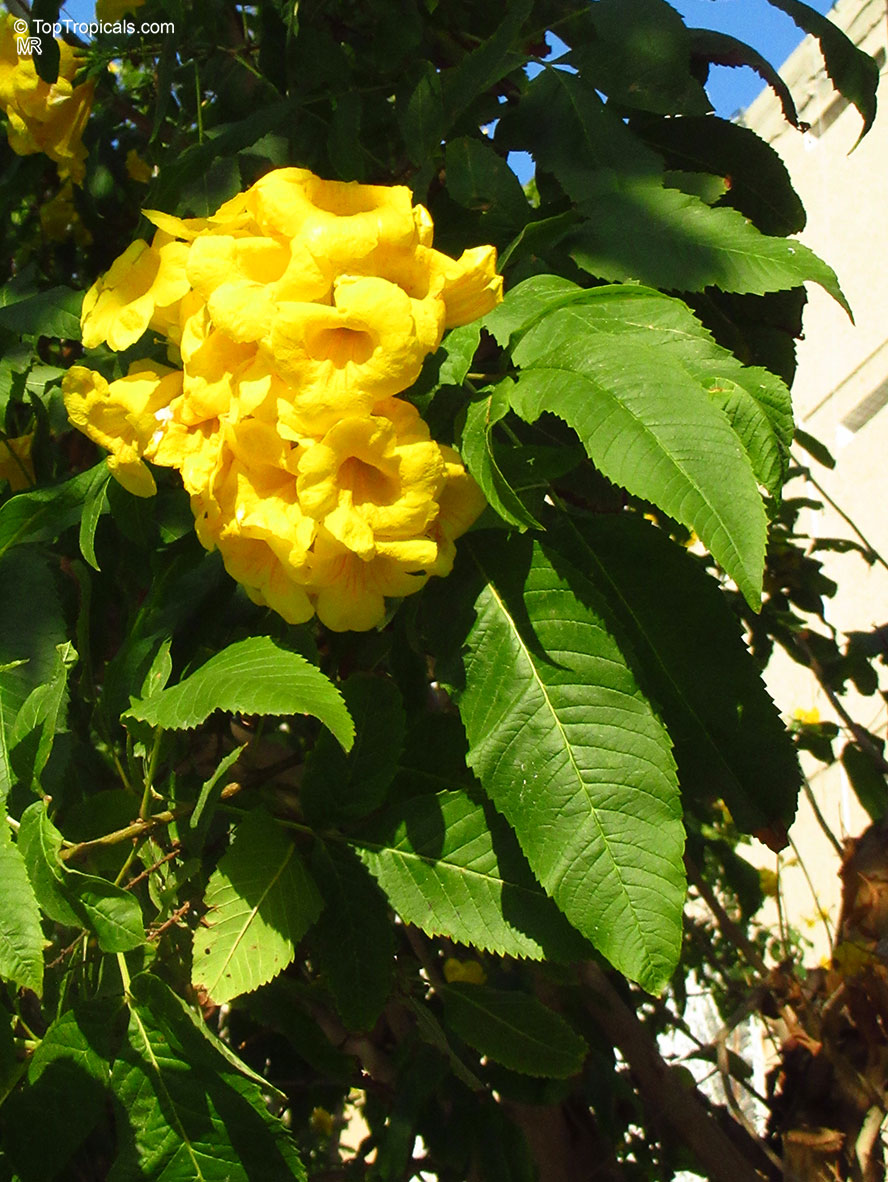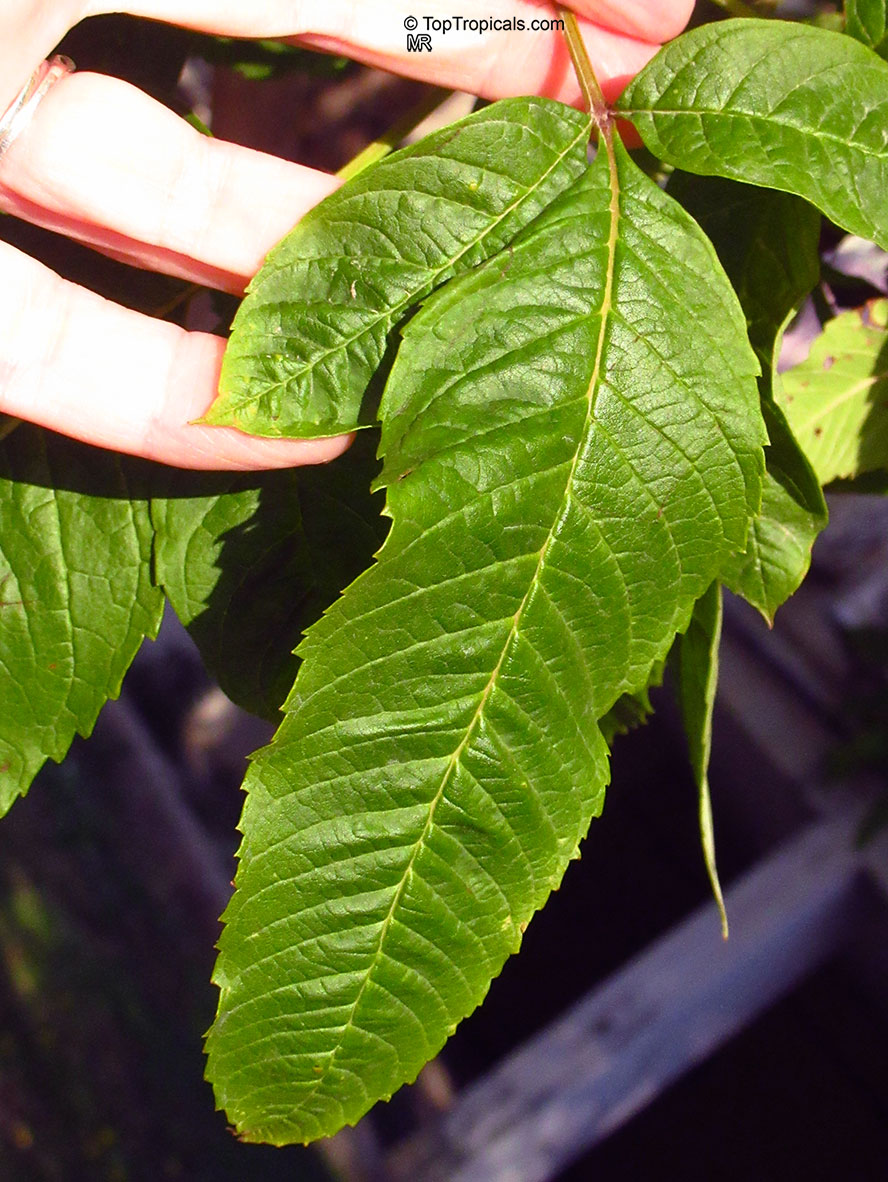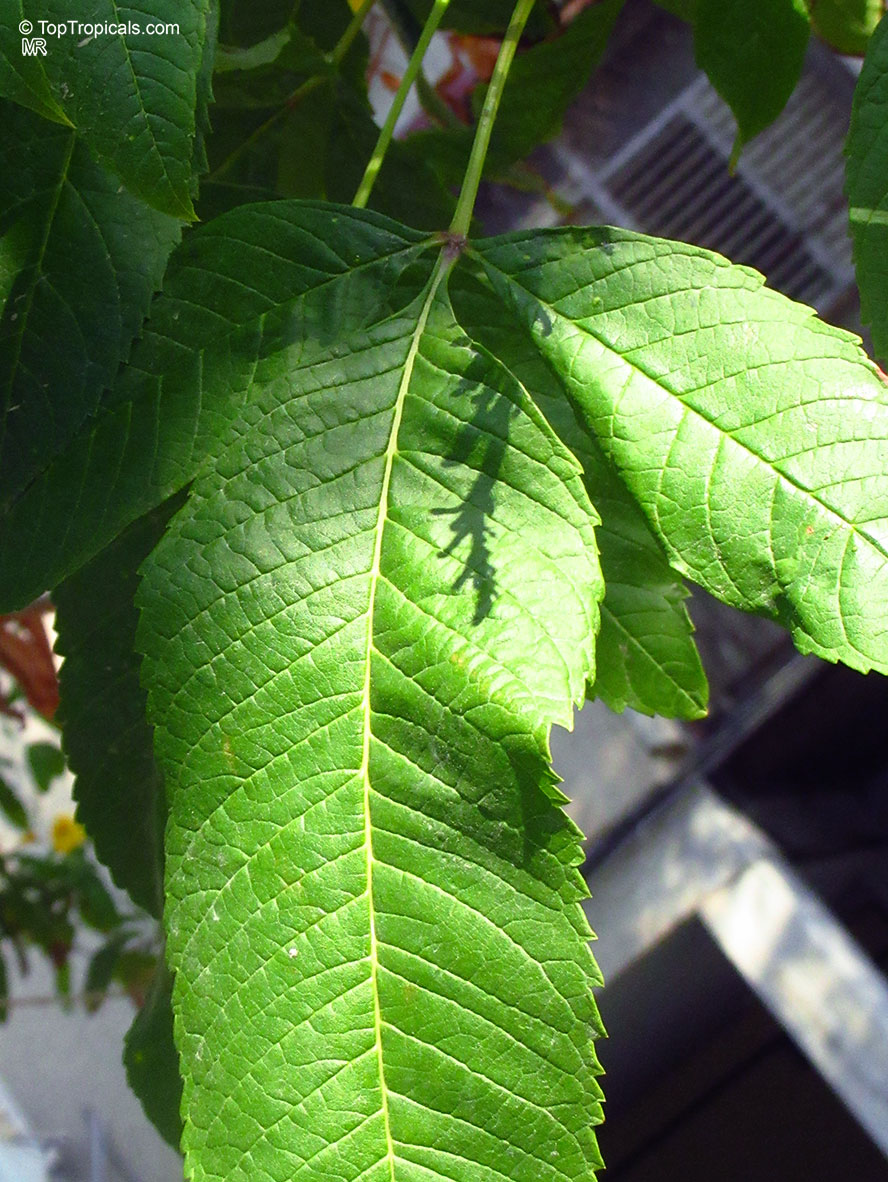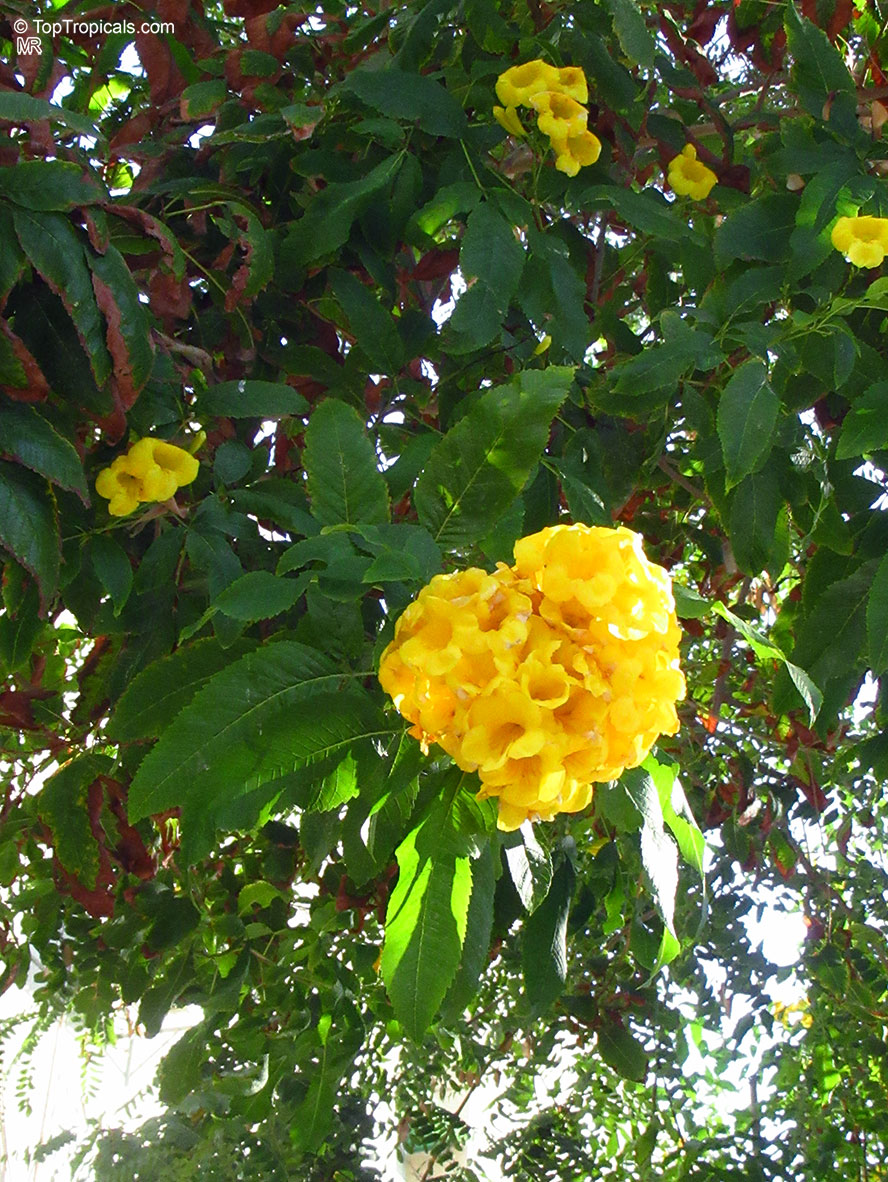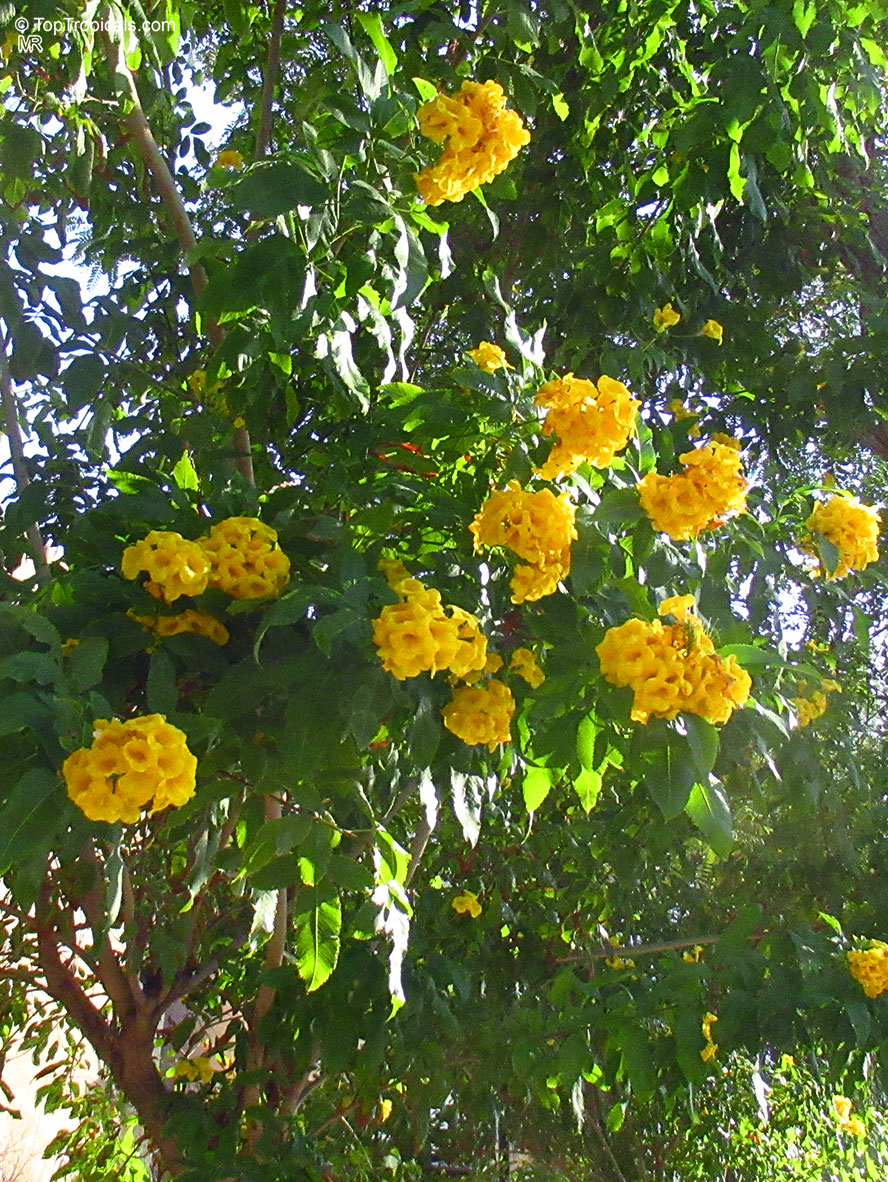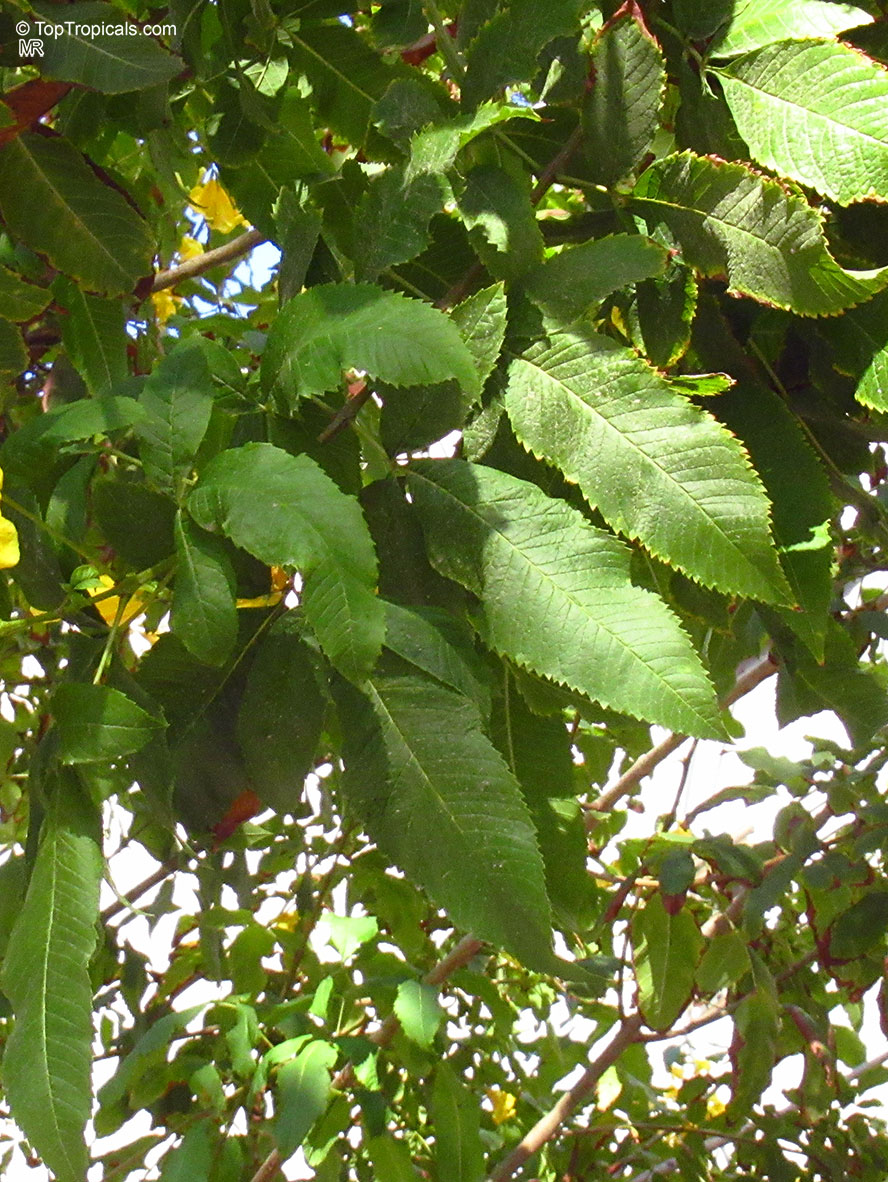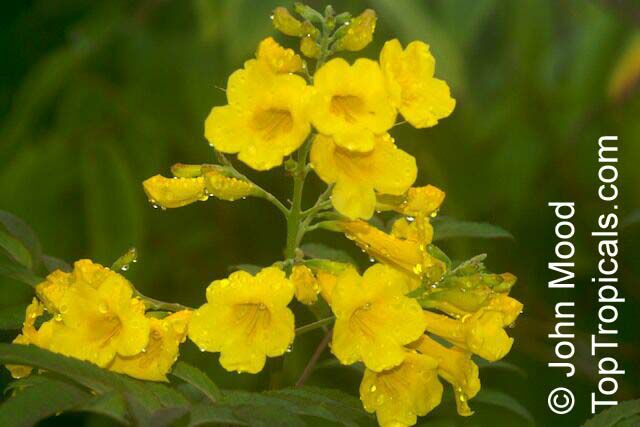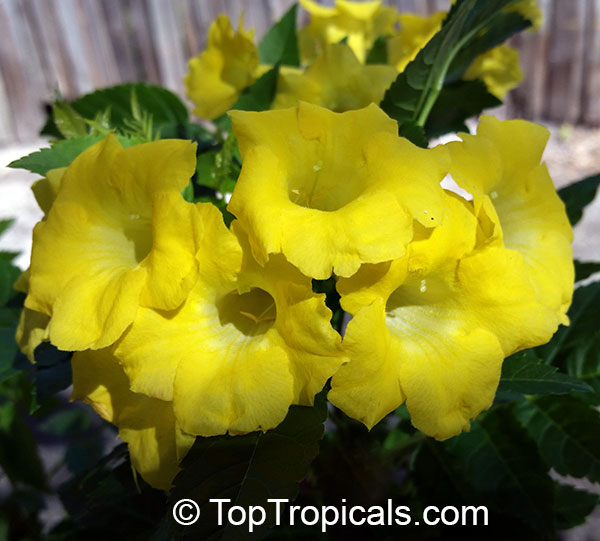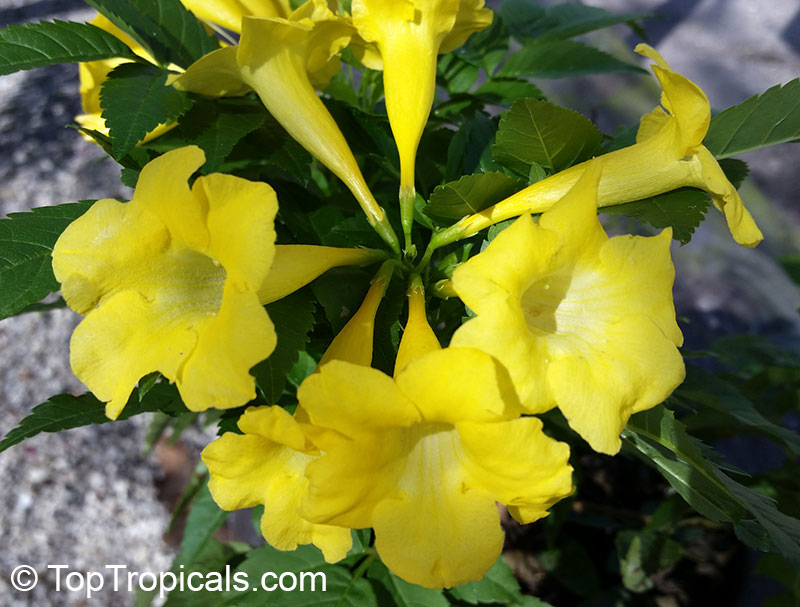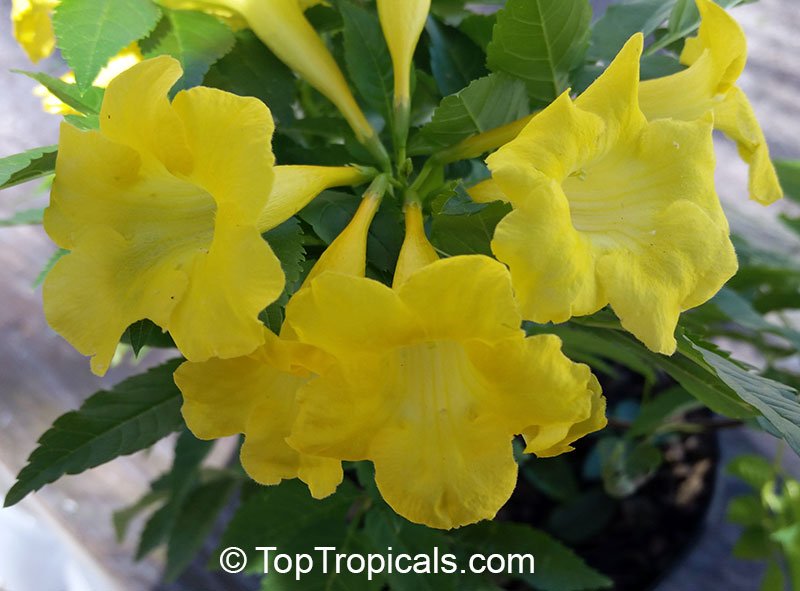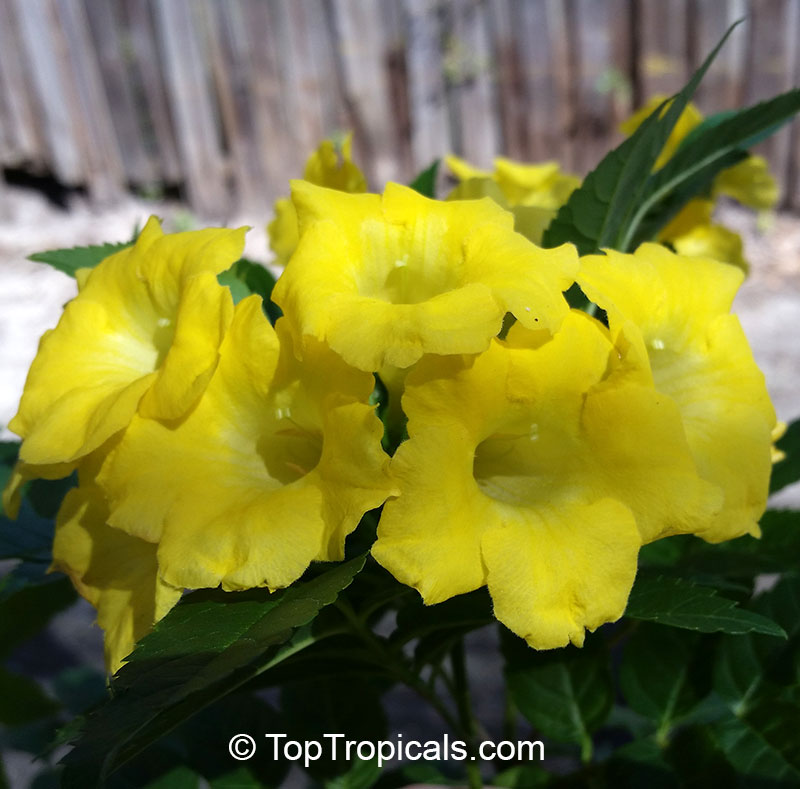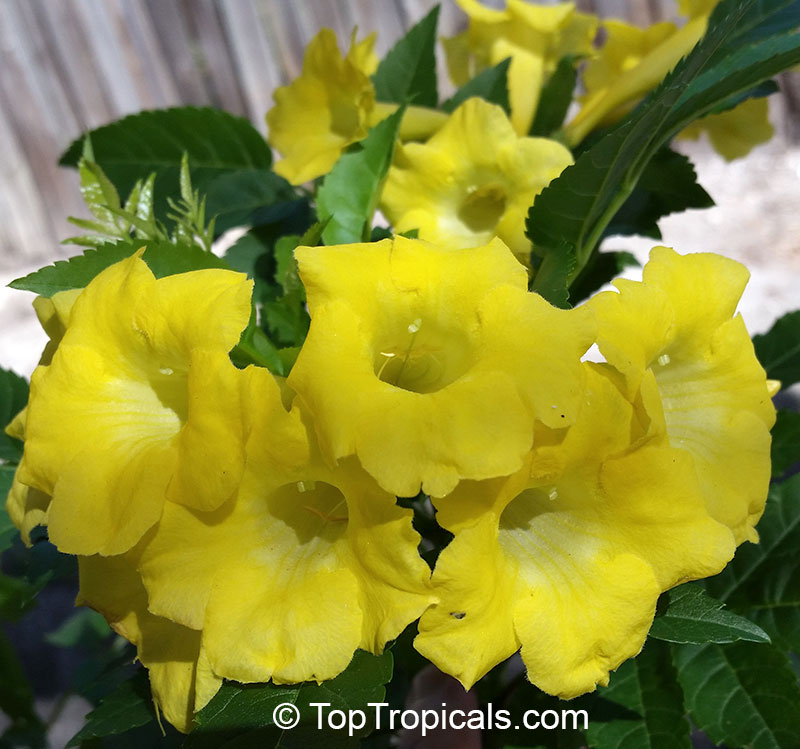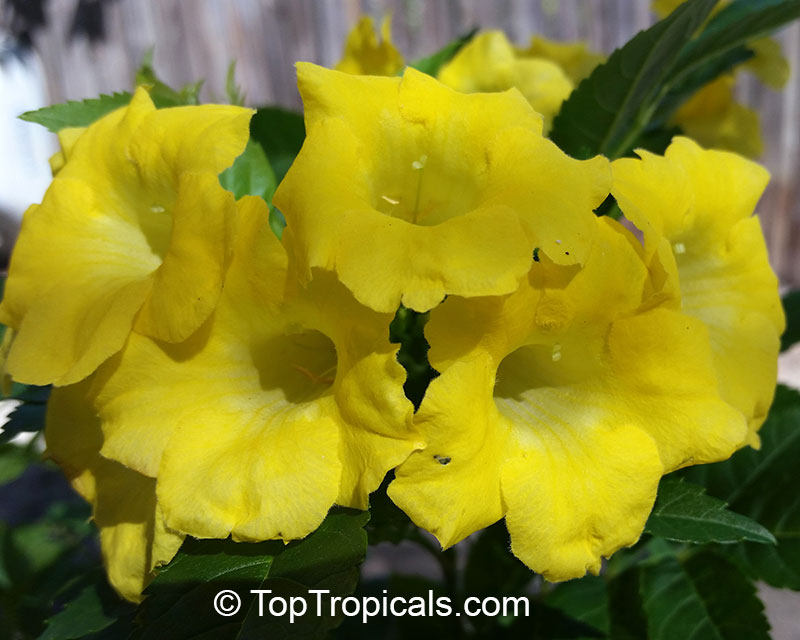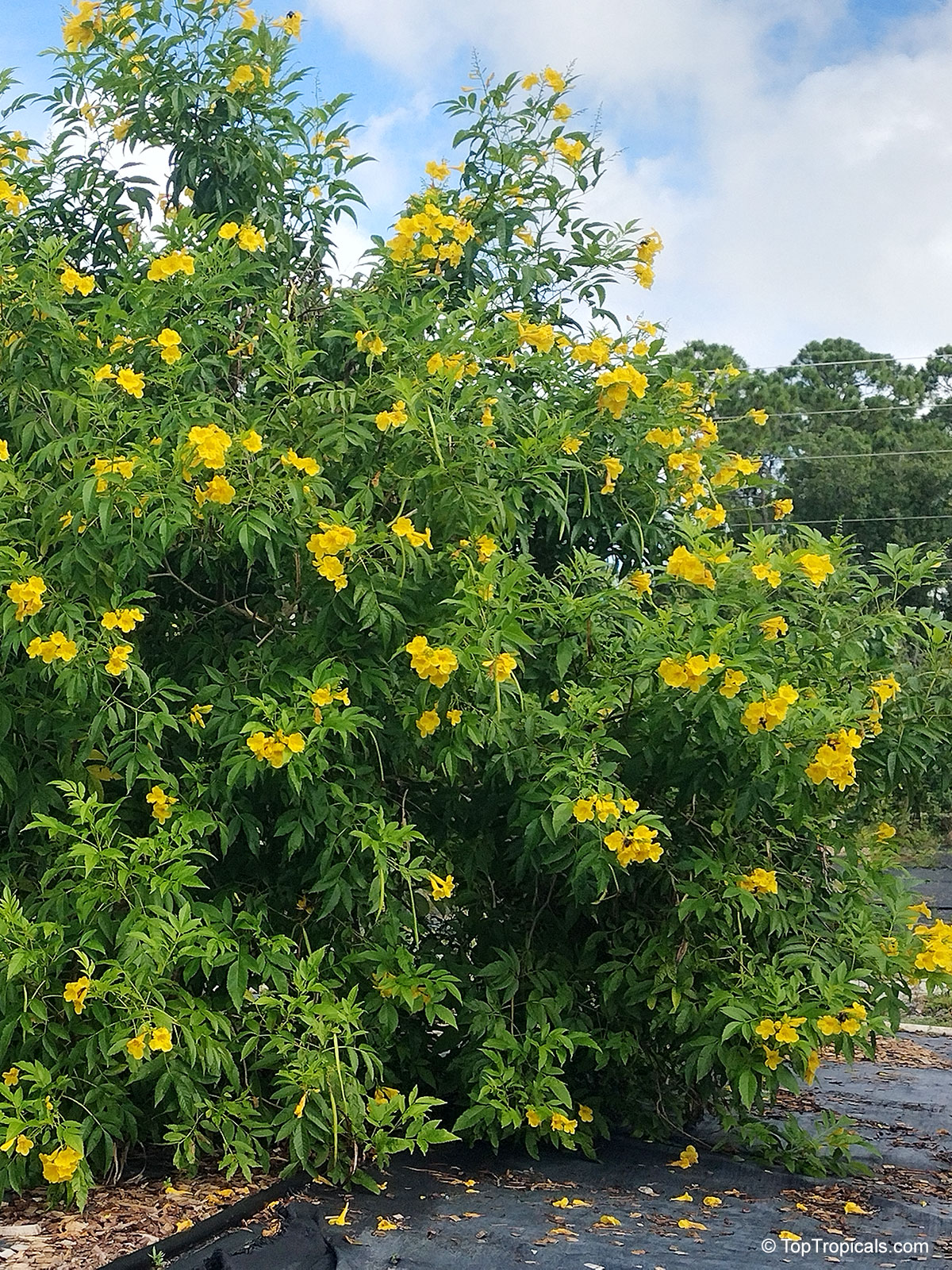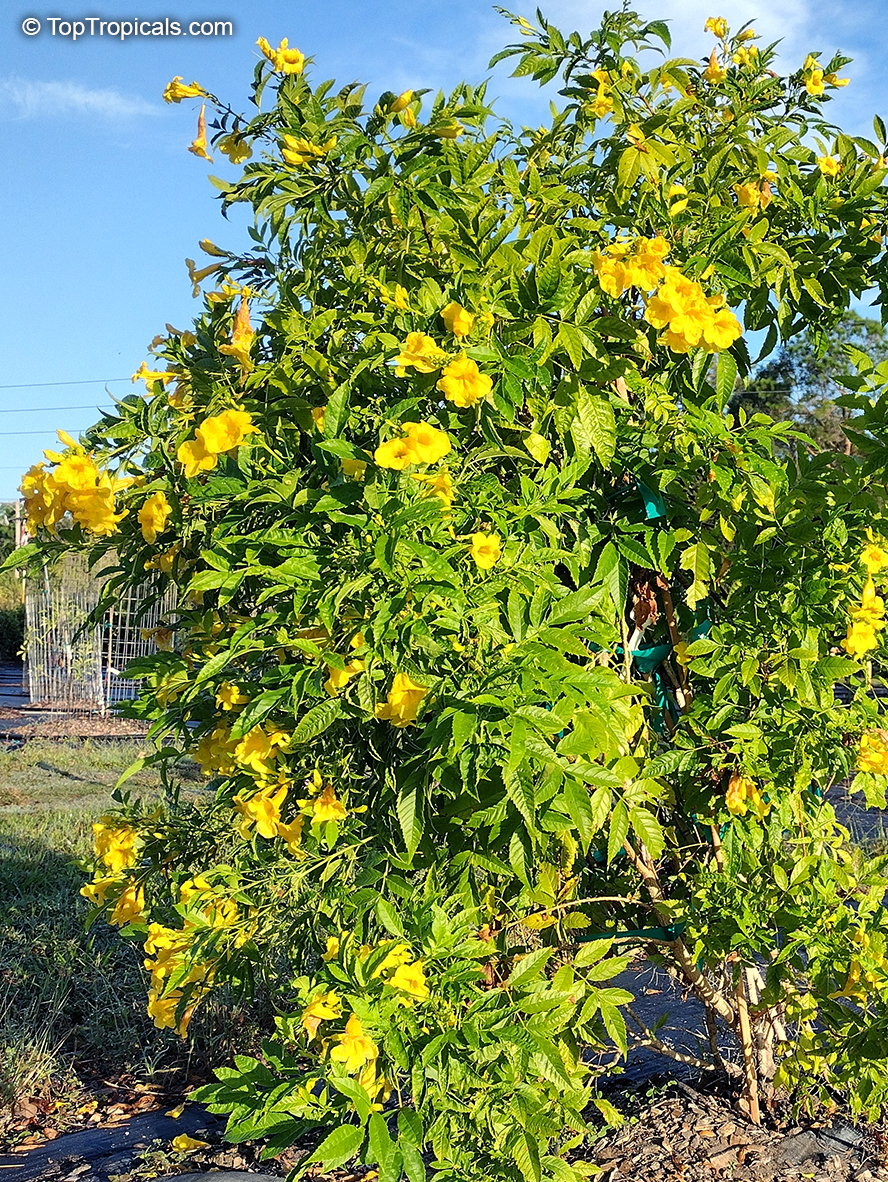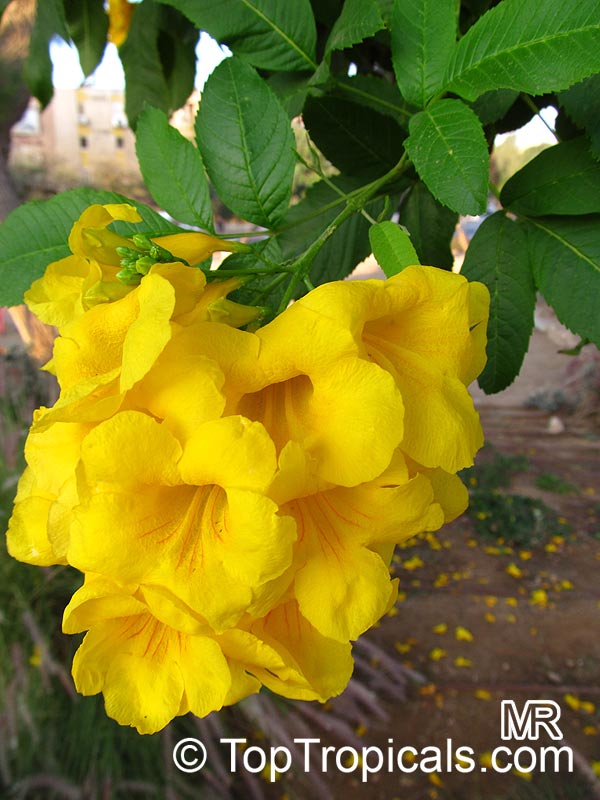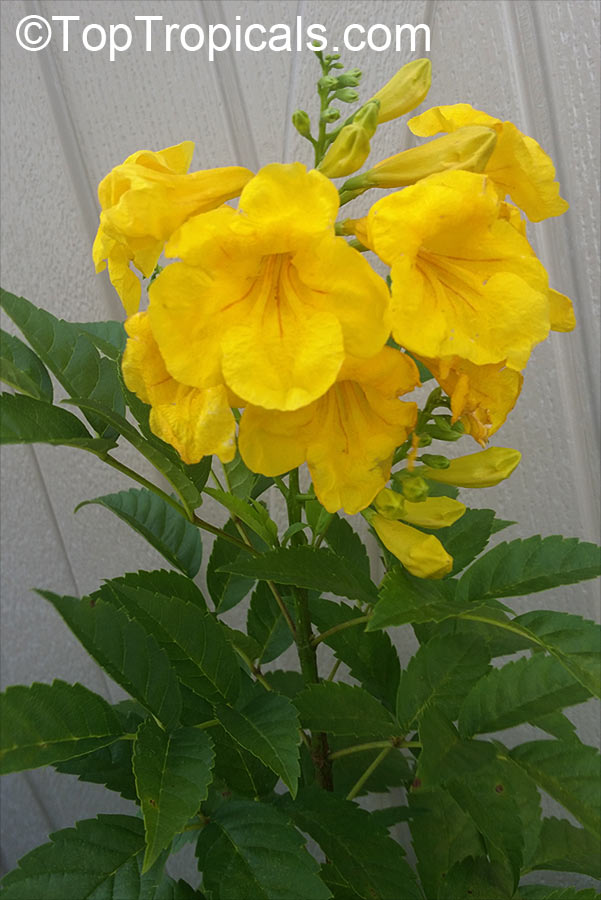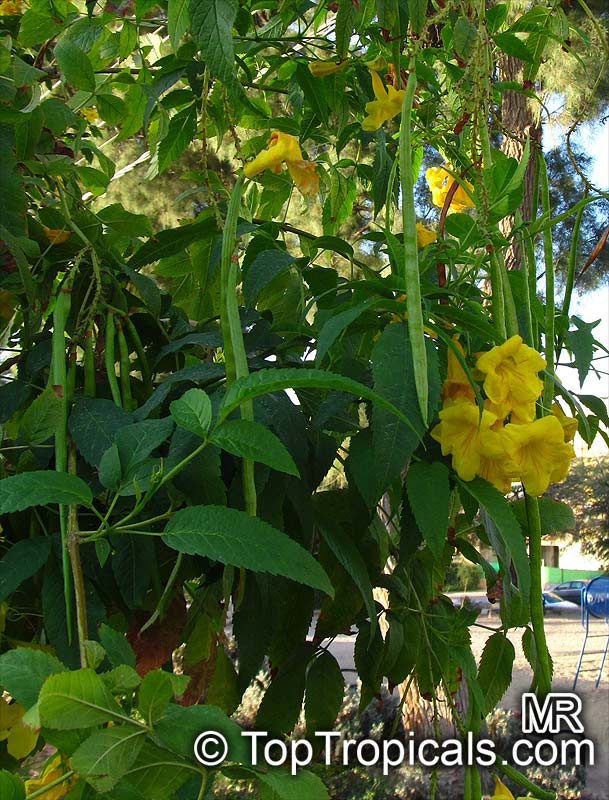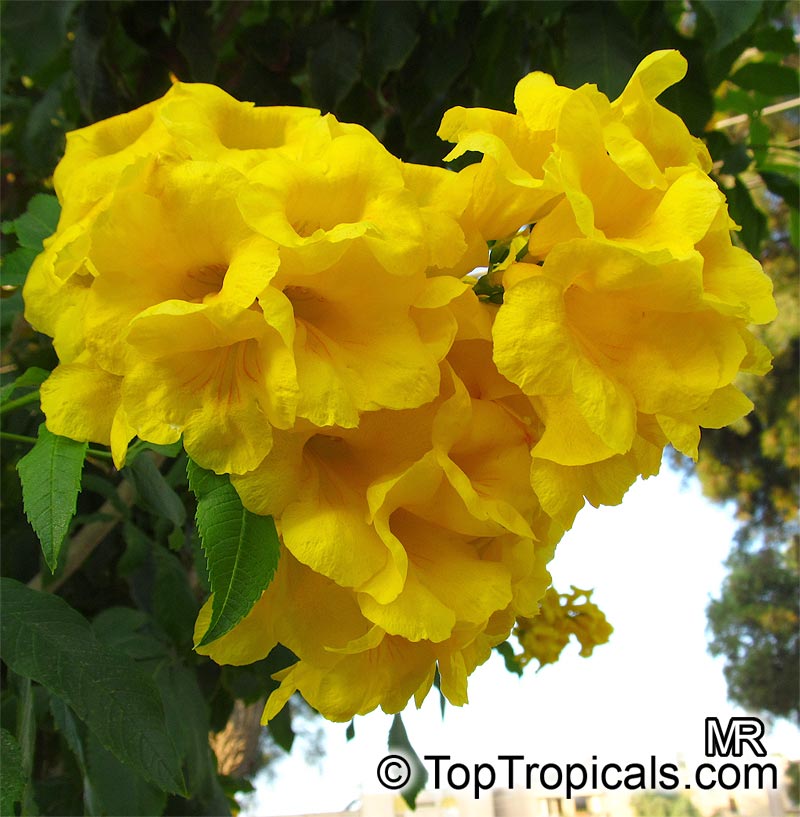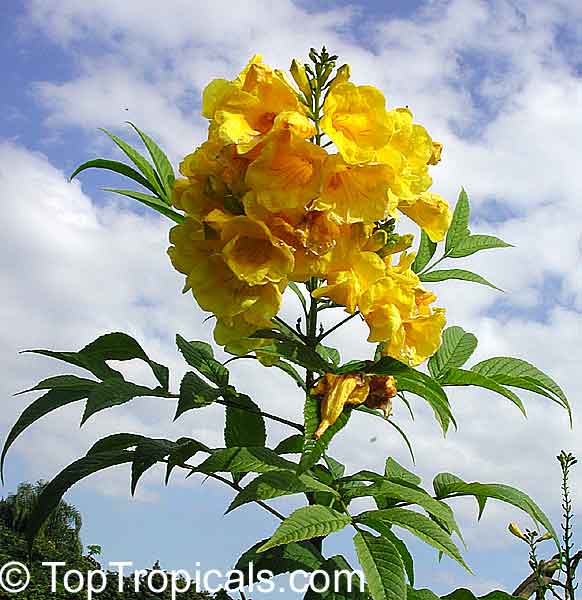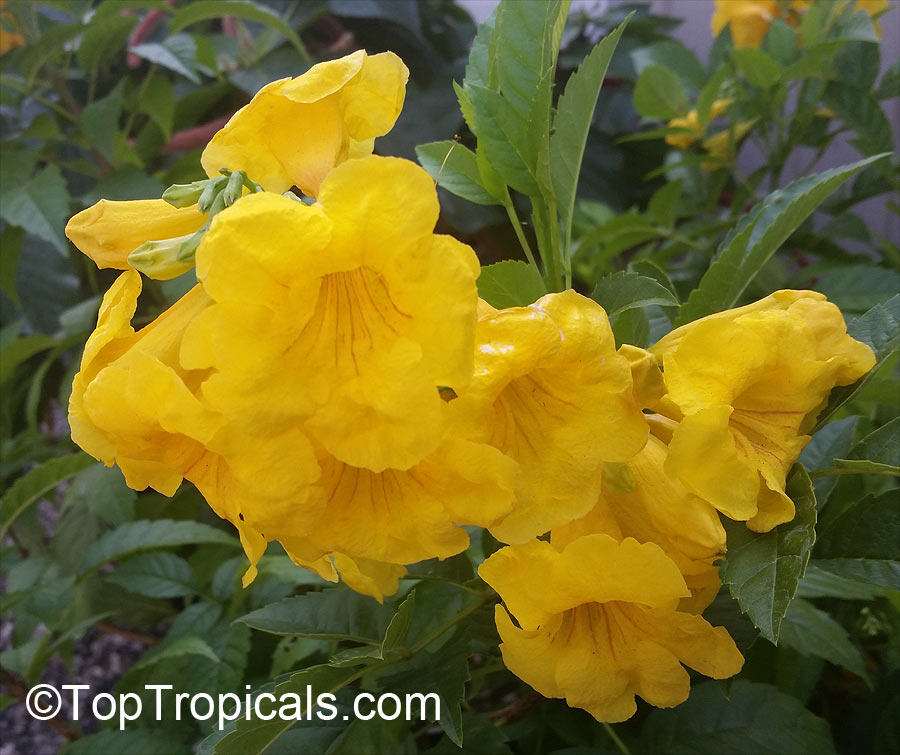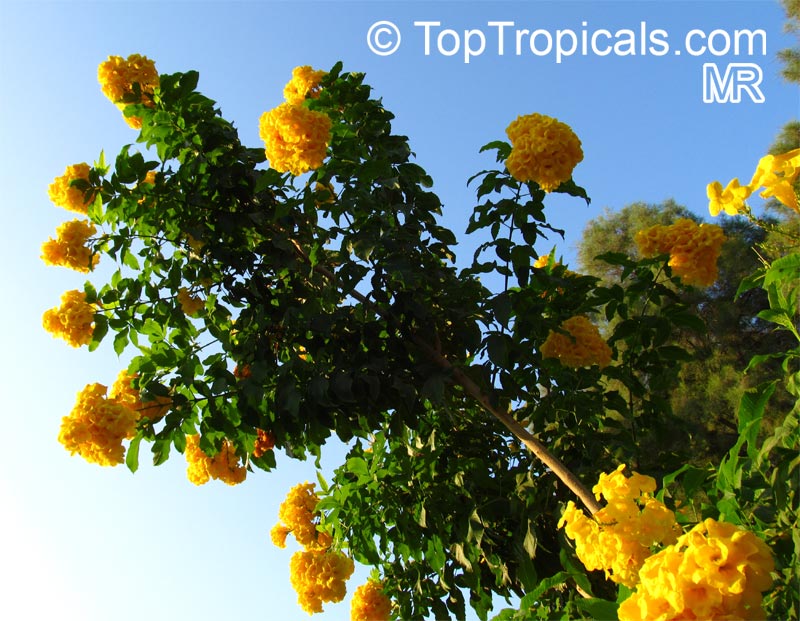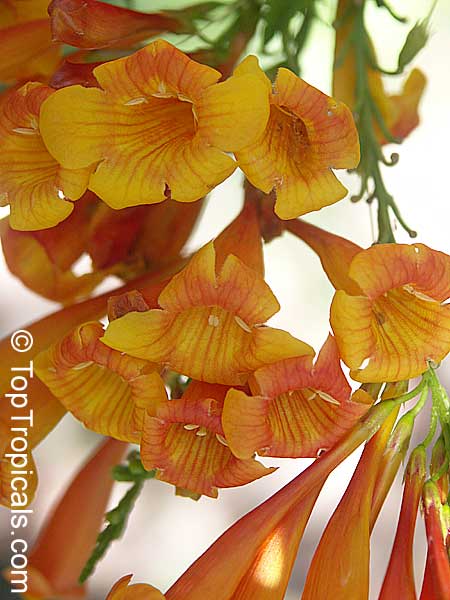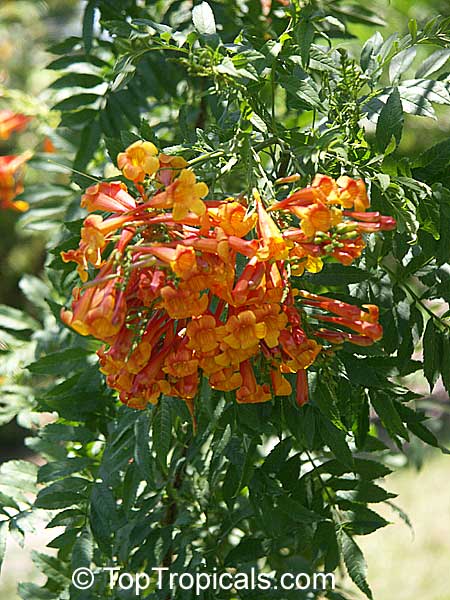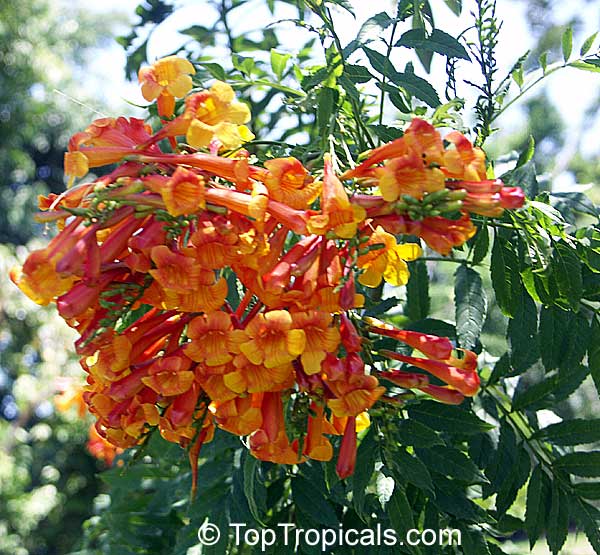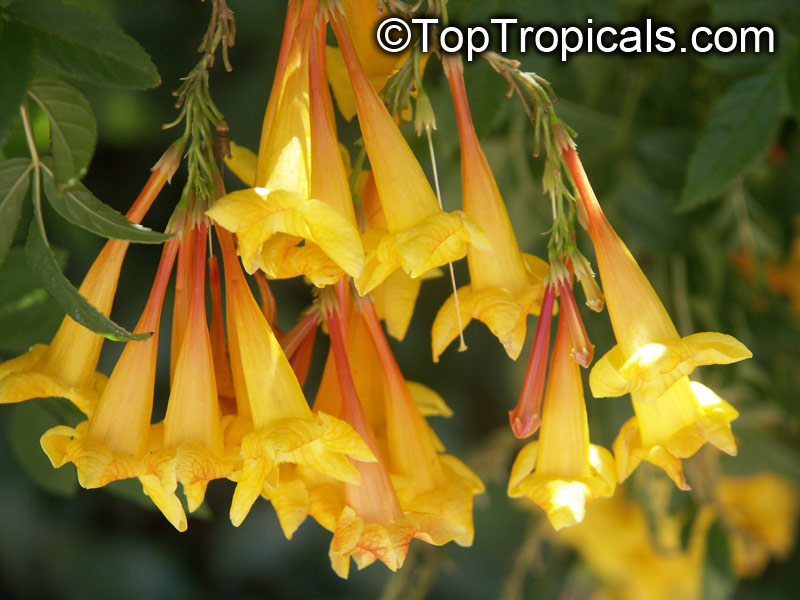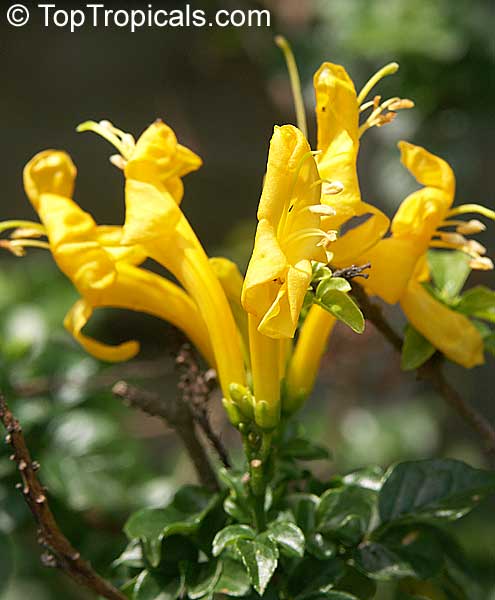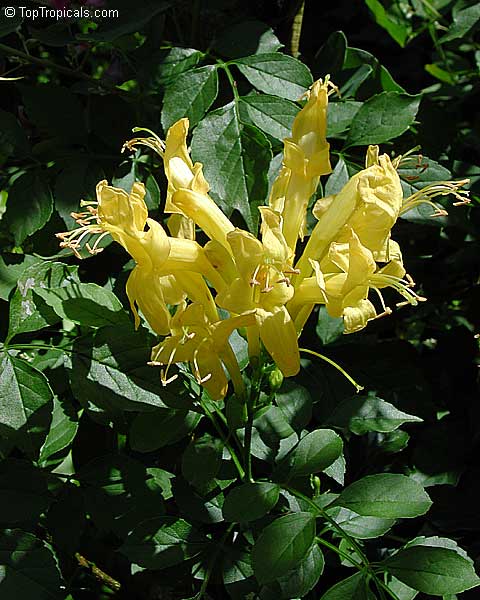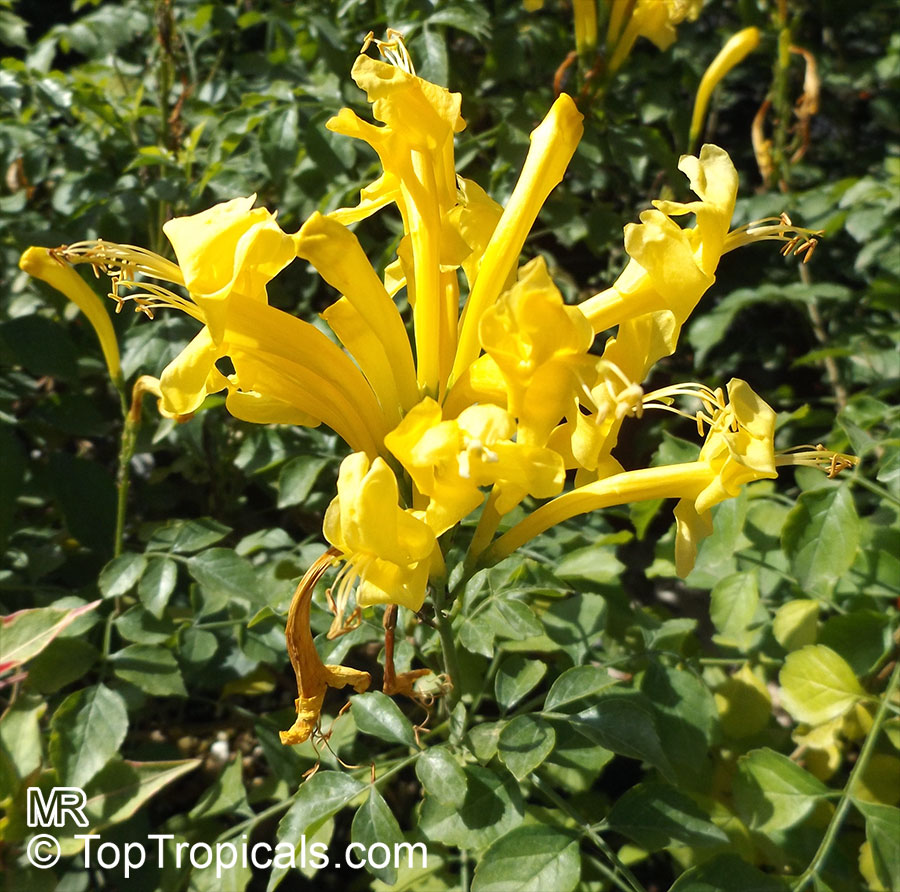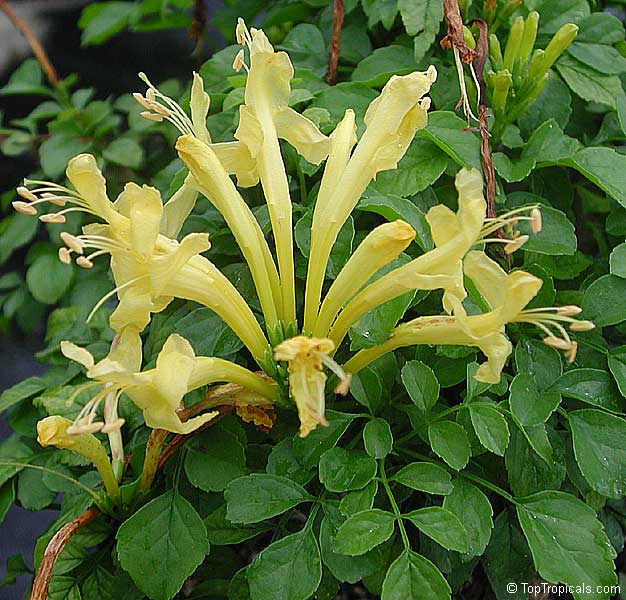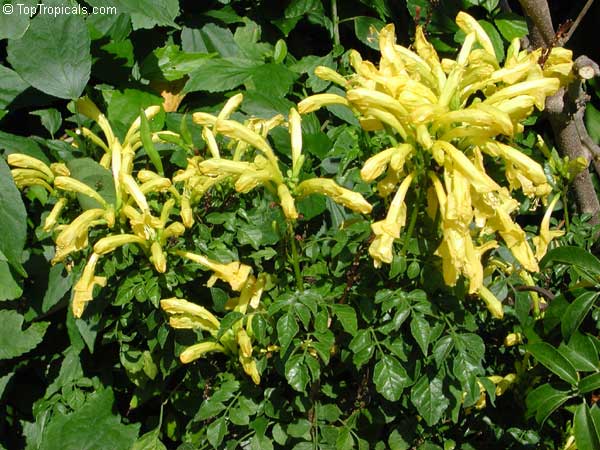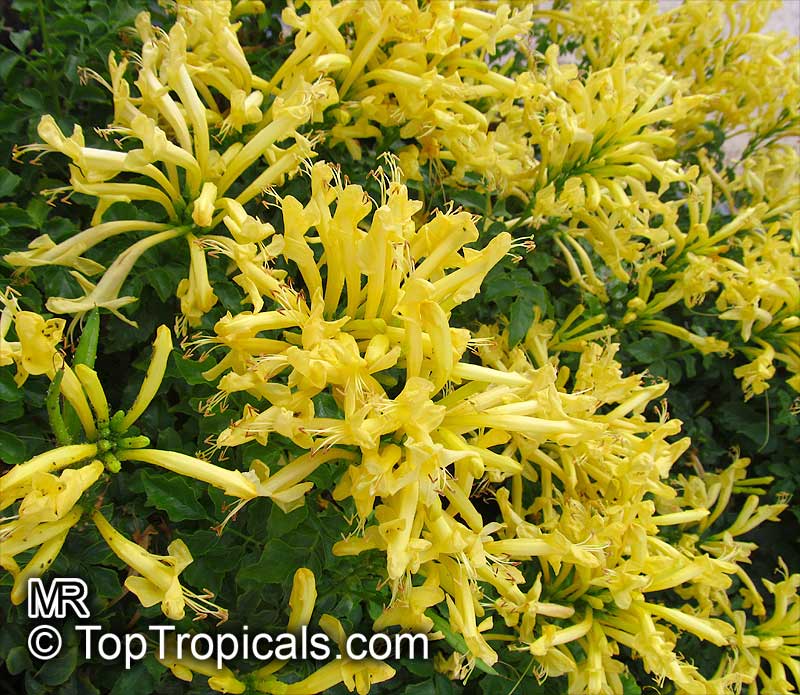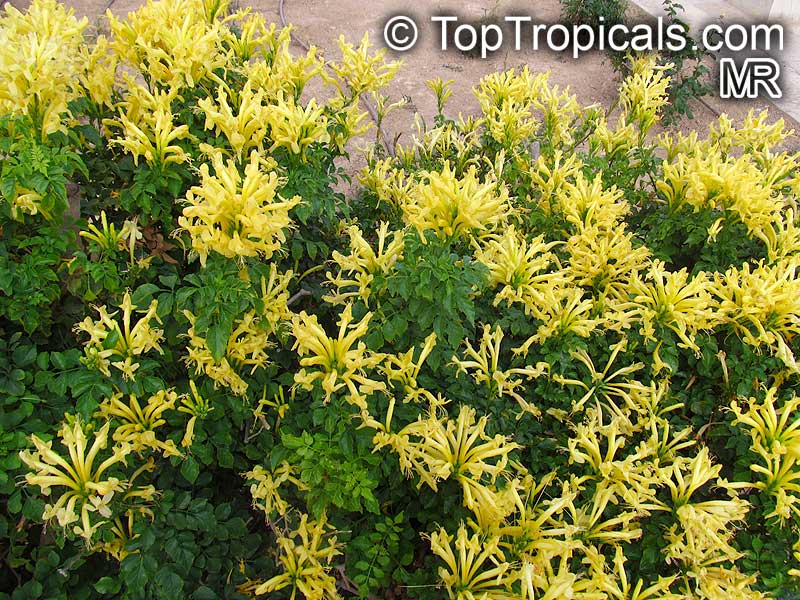Tecoma - Plant Encyclopedia Results
Top Tropicals Plant Encyclopedia
| Number of plants found: 15 | Next | 
|
Go to page: | 1 | 2 |
Botanical names: Pandorea jasminoides, Bignonia jasminoides, Tecoma jasminoides
Common names: Pandora vine, Bower vine, Southern Bell
Family: Bignoniaceae









Pandorea jasminoides, commonly known as Pandora vine, is a hardy, woody-stemmed vine in the Bignoniaceae family. Native to South Africa and parts of Florida, this ornamental foliage boasts pale pink or alba white, fragrant flowers that blossom on its twining branches in spring and summer. The blossoms have bright yellow petals, with red or purple markings in the throat, making it an attractive ornamental species.
Pandora vine are adaptable to most soils, but thrive in moist, fertile, and well-draining soil. They prefer full sun to semi-shade, and should be watered regularly throughout the growing season, except in extremely dry conditions. This drought tolerant variety is hardy to grow in USDA Zones 9-10, and can be grown in cooler climates with a bit of effort.
Pandora vine is relatively easy to care for in pots, but should be grown in large, deep containers for best results. The vine prefers slightly acidic conditions, and due to its sensitivity to temperatures below freezing, it should be transplanted in mid-summer in cooler climates in order to avoid the cold winter temperatures. If the vine is expected to survive a cold winter, it should be mulched with evergreen boughs or leaves for extra insulation before the frost sets in.
In warmer climates, the Pandora vine needs little pruning and is widely used as groundcover and to decorate fences and walls.In cooler regions, it needs a little more maintenance and pruning in order to keep a neat, compact shape. The vines may require support when they become top-heavy, and can be tied to trellises to encourage the most beautiful cascading growth.
Overall, Pandorea jasminoides is an easy-care and drought tolerant vine that is ideal for growing in warmer climates and making the most of its presentable foliage and delicate flowers. When looked after correctly, it can make a beautiful addition to any garden.
Botanical names: Podranea ricasoliana, Tecoma ricasoliana
Common names: Port St. John's Creeper, Zimbabwe Creeper
Family: Bignoniaceae
Origin: Central America, Africa






Podranea ricasoliana is an evergreen or deciduous twining vine with rapid growth potential, reaching up to 20 feet (6m) in height. Its pink flowers bloom in spring and fall and appear on the vine profusely. It requires little to moderate water and needs good drainage in order to flourish.
The vine grows best in full sun and in USDA hardiness zones 9-11. However, it is able to tolerate lower temperatures below freezing in colder zones. Growers should provide additional frost protection for container-grown plants; making sure to keep them in a sheltered area and mulch them for additional insulation. Pruning back the foliage is also recommended if the plant gets leggy.
Partial shade will also suffice but if necessary, the plant should be pruned back to maintain an attractive appearance. Quality fertilizer should be administered to ensure a healthy container plant and water should be applied sparingly in winter. Also, the soil should be repotted every two years, deadheaded and kept frost-free.
The pleasing and hardy features of the Podranea ricasoliana are easy to slide it into any garden; making it an ideal choice with its drought tolerance, lack of pest and disease issues, showy foliage, colorful blooms and heavenly scent.
Botanical names: Tabebuia alba, Tecoma alba
Common name: Lapacho Amarillo
Family: Bignoniaceae
Origin: Brazil






Botanical names: Tecoma alata, Tecoma elat, aTecoma guarume
Common names: Orange Trumpet Flower, Cahuato, Orange Bells, Yellow Bells
Family: Bignoniaceae
Origin: Peru







Tecoma alata, also known as the Orange Trumpet flower is a large shrub or a vine or creeper native to Peru. Growing anywhere from 5-10ft tall, this plant is an eye catcher with its bright yellow and orange flowers that attract butterflies and hummingbirds. Beautiful loose clusters of orange trumpet-like blooms are borne from mid-summer to fall on this upright to spreading woody perennial. It grows best in full sun to semi-shade and needs regular watering. Once it reaches maturity it is fairly hardy, able to withstand temperatures as low as 30°F for a short period of time. This beauty can be grown in USDA Zones 8-11. Dwarf variety hybrid is very slow growing and has well-branched with compact habit.
When grown in a pot the Tecoma alata will require the same full sun position. Make sure to provide it with the same regular watering and fertilizer applications to keep it healthy. What's great about keeping it in a pot is that you can move it indoors to a cool, protected area during the cooler months so it is able to withstand temperatures lower than 30°F when grown in cold regions. The beauty of this plant's size means it is perfect as a container plant and a great addition to your porch or patio.
Recommended Fertilizer: SUNSHINE Megaflor - Bloom Nutrition Booster
Botanical names: Tecoma castanifolia, Bignonia castaneifolia, Bignonia serrata, Tecoma gaudichaudii
Common name: Yellow Bells
Family: Bignoniaceae
Origin: Central America






Tecoma castanifolia is similar to Tecoma stans, but Tecoma stans has compound leaves, while Tecoma castanifolia has simple leaves, sometimes with three leaflets.
Large heads of golden-yellow trumpet flowers over a long period. Its a very attractive small tree or shrub. Spectacular heat-tolerant and highly pest resistant.
Botanical name: Tecoma sambucifolia
Common name: Trumpet Flower
Family: Bignoniaceae
Origin: Tropical America








Shrubby tree, known for its many bright, yellow colored flowers borne in large clusters.
Botanical name: Tecoma sp.
Common names: Tecoma Lydia, Yellow Bells, Yellow Elder
Cultivar: Lydia
Family: Bignoniaceae
Origin: Tropical America






Lydia is a product of Tecoma breeding project of George Hull in Phoenix. She is indeed a beautiful everbloomer that can be expected to be in bloom from very early spring until frost.
Compared to other yellow Tecomas, Lydia is a very compact, dwarf shrub, flowers are clear, soft lemon-yellow color with white throat. Unlike traditional varieties, it is a sterile hybrid that doesn't produce messy seeds that most tecomas do.
Tecomas do appreciate a bit of extra fertilizer so monthly during the growing season, a small application will induce more new growth and flowering.
Botanical names: Tecoma stans, Bignonia stans
Common names: Yellow Elder, Yellow Bells
Family: Bignoniaceae
Origin: Tropical America










Large heads of golden-yellow trumpet flowers over a long period. Its a very attractive small tree or shrub. Spectacular heat-tolerant and highly pest resistant. Wonderful in containers to accent entry and patio, also in mass plantings.
Recommended Fertilizer: SUNSHINE Megaflor - Bloom Nutrition Booster
Ordering seeds info
RECOMMENDED SUPPLIES:
Seed Germination Mix #3, professional grade
SUNSHINE-Epi - Seeds and cuttings booster
SUNSHINE Bombino - Young Plant Booster
Botanical name: Tecoma x smithii
Common name: Orange Bells
Family: Bignoniaceae






'Orange Bells' (Tecoma x smithii) is a cross of T. arequipensis and T. stans.
Botanical names: Tecomaria capensis, Tecoma capensis var. aurea
Common name: Cape Honeysuckle
Cultivar: Aurea
Family: Bignoniaceae
Origin: South Africa









This is a sprawling plant that, if left unpinned, puts out long stems and becomes almost a vine that needs some kind of support. Usually kept clipped, it is often used as a low hedge. It has attractive, light green foliage and frequent displays of long, tubular yellow flowers at the ends of the stems. Cape Honeysuckle needs very well-drained soil and prefers full sun, but will bloom in filtered light; flowering is best is slightly cooler climates.
| Next |  |
Use link to repeat this search:
https://toptropicals.com/cgi-bin/garden_catalog/cat.cgi?find=Tecoma&search_op=and&keyword_op=and&language=e&number=10
&no_change_lang=1&user=tt&sale=1&first=0
